Social Forces 98(2) - Gender Inequality in Product Markets Research
VerifiedAdded on 2022/09/22
|30
|15731
|23
Report
AI Summary
This research paper, published in Social Forces, investigates gender inequality in product markets through three online experiments. The study, conducted by Elise Tak, Shelley J. Correll, and Sarah A. Soule at Stanford University, explores how gender status beliefs influence product evaluations. The authors develop a theory of status belief transfer, demonstrating that products made by women are disadvantaged in male-typed markets (craft beer) but not in female-typed markets (cupcakes). The research reveals an asymmetric negative bias, where products made by women receive lower evaluations in male-dominated markets. The study also examines the moderating effects of external status conferral and evaluator's product knowledge. The findings highlight the pervasive influence of gender-typing in product markets and suggest strategies to mitigate gender biases, drawing on status characteristics theory (SCT) to explain how these biases are perpetuated.
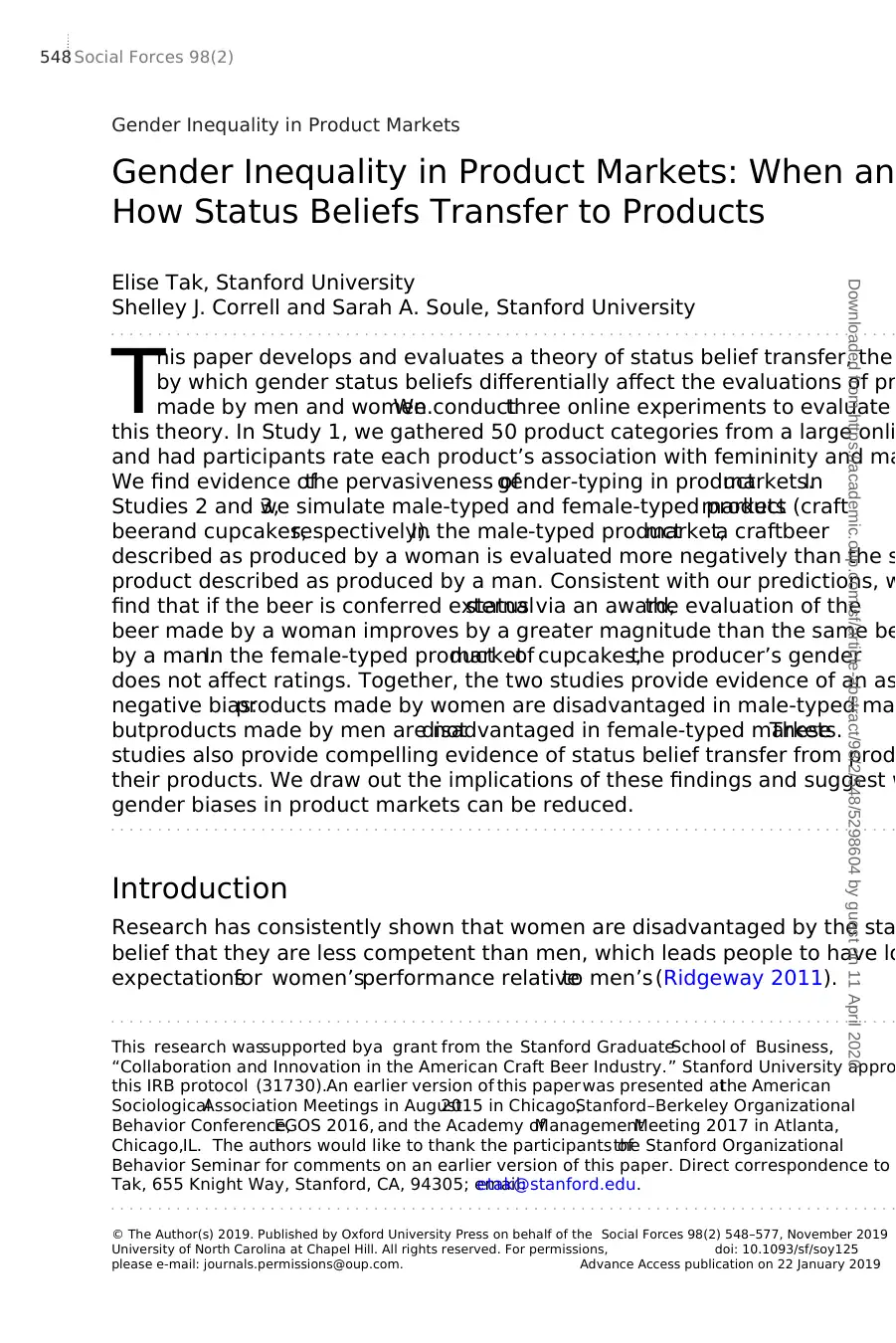
. . . . . . . . . . . . . . . . . . . . . . . . . . . . . . . . . . . . . . . . . . . . . . . . . . . . . . . . . . . . . . . . . . . . . . . . . . . . . . . . . . . .
. . . . . . . . . . . . . . . . . . . . . . . . . . . . . . . . . . . . . . . . . . . . . . . . . . . . . . . . . . . . . . . . . . . . . . . . . . . . . . . . . . . .
Gender Inequality in Product Markets: When an
How Status Beliefs Transfer to Products
Elise Tak, Stanford University
Shelley J. Correll and Sarah A. Soule, Stanford University
This paper develops and evaluates a theory of status belief transfer, the
by which gender status beliefs differentially affect the evaluations of pr
made by men and women.We conductthree online experiments to evaluate
this theory. In Study 1, we gathered 50 product categories from a large onli
and had participants rate each product’s association with femininity and ma
We find evidence ofthe pervasiveness ofgender-typing in productmarkets.In
Studies 2 and 3,we simulate male-typed and female-typed productmarkets (craft
beerand cupcakes,respectively).In the male-typed productmarket,a craftbeer
described as produced by a woman is evaluated more negatively than the s
product described as produced by a man. Consistent with our predictions, w
find that if the beer is conferred externalstatus via an award,the evaluation of the
beer made by a woman improves by a greater magnitude than the same be
by a man.In the female-typed productmarketof cupcakes,the producer’s gender
does not affect ratings. Together, the two studies provide evidence of an as
negative bias:products made by women are disadvantaged in male-typed ma
butproducts made by men are notdisadvantaged in female-typed markets.These
studies also provide compelling evidence of status belief transfer from prod
their products. We draw out the implications of these findings and suggest w
gender biases in product markets can be reduced.
Introduction
Research has consistently shown that women are disadvantaged by the sta
belief that they are less competent than men, which leads people to have lo
expectationsfor women’sperformance relativeto men’s (Ridgeway 2011).
. . . . . . . . . . . . . . . . . . . . . . . . . . . . . . . . . . . . . . . . . . . . . . . . . . . . . . . . . . . . . . . . . . . . . . . . . . . . . . . . . . . .
This research wassupported bya grant from the Stanford GraduateSchool of Business,
“Collaboration and Innovation in the American Craft Beer Industry.” Stanford University appro
this IRB protocol (31730).An earlier version of this paper was presented atthe American
SociologicalAssociation Meetings in August2015 in Chicago,Stanford–Berkeley Organizational
Behavior Conference,EGOS 2016, and the Academy ofManagementMeeting 2017 in Atlanta,
Chicago,IL. The authors would like to thank the participants ofthe Stanford Organizational
Behavior Seminar for comments on an earlier version of this paper. Direct correspondence to
Tak, 655 Knight Way, Stanford, CA, 94305; email:etak@stanford.edu.
. . . . . . . . . . . . . . . . . . . . . . . . . . . . . . . . . . . . . . . . . . . . . . . . . . . . . . . . . . . . . . . . . . . . . . . . . . . . . . . . . . . .
© The Author(s) 2019. Published by Oxford University Press on behalf of the
University of North Carolina at Chapel Hill. All rights reserved. For permissions,
please e-mail: journals.permissions@oup.com.
Social Forces 98(2) 548–577, November 2019
doi: 10.1093/sf/soy125
Advance Access publication on 22 January 2019
Gender Inequality in Product Markets
Social Forces 98(2)548
Downloaded from https://academic.oup.com/sf/article-abstract/98/2/548/5298604 by guest on 11 April 2020
. . . . . . . . . . . . . . . . . . . . . . . . . . . . . . . . . . . . . . . . . . . . . . . . . . . . . . . . . . . . . . . . . . . . . . . . . . . . . . . . . . . .
Gender Inequality in Product Markets: When an
How Status Beliefs Transfer to Products
Elise Tak, Stanford University
Shelley J. Correll and Sarah A. Soule, Stanford University
This paper develops and evaluates a theory of status belief transfer, the
by which gender status beliefs differentially affect the evaluations of pr
made by men and women.We conductthree online experiments to evaluate
this theory. In Study 1, we gathered 50 product categories from a large onli
and had participants rate each product’s association with femininity and ma
We find evidence ofthe pervasiveness ofgender-typing in productmarkets.In
Studies 2 and 3,we simulate male-typed and female-typed productmarkets (craft
beerand cupcakes,respectively).In the male-typed productmarket,a craftbeer
described as produced by a woman is evaluated more negatively than the s
product described as produced by a man. Consistent with our predictions, w
find that if the beer is conferred externalstatus via an award,the evaluation of the
beer made by a woman improves by a greater magnitude than the same be
by a man.In the female-typed productmarketof cupcakes,the producer’s gender
does not affect ratings. Together, the two studies provide evidence of an as
negative bias:products made by women are disadvantaged in male-typed ma
butproducts made by men are notdisadvantaged in female-typed markets.These
studies also provide compelling evidence of status belief transfer from prod
their products. We draw out the implications of these findings and suggest w
gender biases in product markets can be reduced.
Introduction
Research has consistently shown that women are disadvantaged by the sta
belief that they are less competent than men, which leads people to have lo
expectationsfor women’sperformance relativeto men’s (Ridgeway 2011).
. . . . . . . . . . . . . . . . . . . . . . . . . . . . . . . . . . . . . . . . . . . . . . . . . . . . . . . . . . . . . . . . . . . . . . . . . . . . . . . . . . . .
This research wassupported bya grant from the Stanford GraduateSchool of Business,
“Collaboration and Innovation in the American Craft Beer Industry.” Stanford University appro
this IRB protocol (31730).An earlier version of this paper was presented atthe American
SociologicalAssociation Meetings in August2015 in Chicago,Stanford–Berkeley Organizational
Behavior Conference,EGOS 2016, and the Academy ofManagementMeeting 2017 in Atlanta,
Chicago,IL. The authors would like to thank the participants ofthe Stanford Organizational
Behavior Seminar for comments on an earlier version of this paper. Direct correspondence to
Tak, 655 Knight Way, Stanford, CA, 94305; email:etak@stanford.edu.
. . . . . . . . . . . . . . . . . . . . . . . . . . . . . . . . . . . . . . . . . . . . . . . . . . . . . . . . . . . . . . . . . . . . . . . . . . . . . . . . . . . .
© The Author(s) 2019. Published by Oxford University Press on behalf of the
University of North Carolina at Chapel Hill. All rights reserved. For permissions,
please e-mail: journals.permissions@oup.com.
Social Forces 98(2) 548–577, November 2019
doi: 10.1093/sf/soy125
Advance Access publication on 22 January 2019
Gender Inequality in Product Markets
Social Forces 98(2)548
Downloaded from https://academic.oup.com/sf/article-abstract/98/2/548/5298604 by guest on 11 April 2020
Paraphrase This Document
Need a fresh take? Get an instant paraphrase of this document with our AI Paraphraser
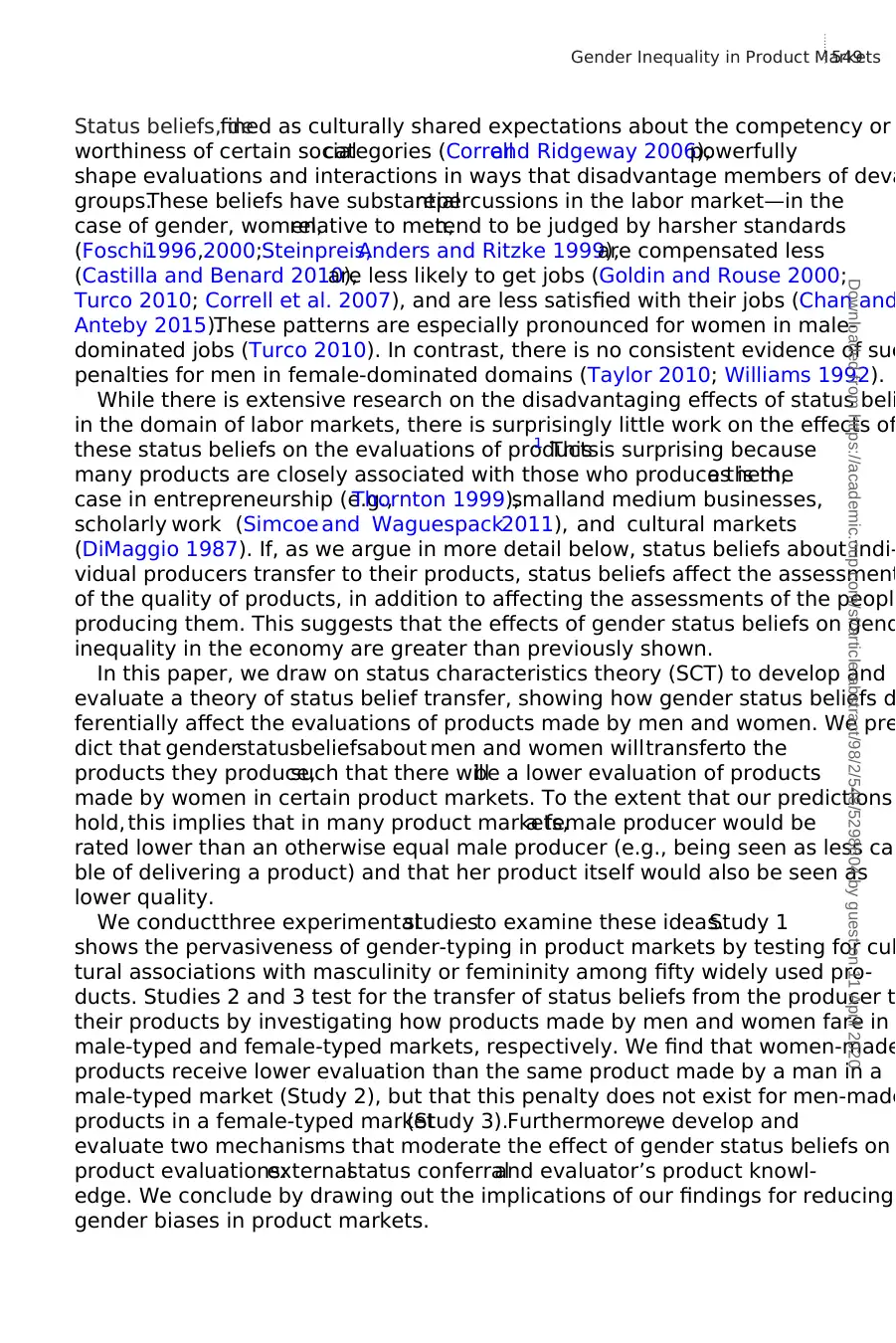
fined as culturally shared expectations about the competency or
worthiness of certain socialcategories (Correlland Ridgeway 2006),powerfully
shape evaluations and interactions in ways that disadvantage members of deva
groups.These beliefs have substantialrepercussions in the labor market—in the
case of gender, women,relative to men,tend to be judged by harsher standards
(Foschi1996,2000;Steinpreis,Anders and Ritzke 1999),are compensated less
(Castilla and Benard 2010),are less likely to get jobs (Goldin and Rouse 2000;
Turco 2010; Correll et al. 2007), and are less satisfied with their jobs (Chan and
Anteby 2015).These patterns are especially pronounced for women in male-
dominated jobs (Turco 2010). In contrast, there is no consistent evidence of suc
penalties for men in female-dominated domains (Taylor 2010; Williams 1992).
While there is extensive research on the disadvantaging effects of status beli
in the domain of labor markets, there is surprisingly little work on the effects of
these status beliefs on the evaluations of products.1 This is surprising because
many products are closely associated with those who produce them,as is the
case in entrepreneurship (e.g.,Thornton 1999),smalland medium businesses,
scholarly work (Simcoe and Waguespack2011), and cultural markets
(DiMaggio 1987). If, as we argue in more detail below, status beliefs about indi-
vidual producers transfer to their products, status beliefs affect the assessment
of the quality of products, in addition to affecting the assessments of the people
producing them. This suggests that the effects of gender status beliefs on gend
inequality in the economy are greater than previously shown.
In this paper, we draw on status characteristics theory (SCT) to develop and
evaluate a theory of status belief transfer, showing how gender status beliefs d
ferentially affect the evaluations of products made by men and women. We pre
dict that genderstatusbeliefsabout men and women willtransferto the
products they produce,such that there willbe a lower evaluation of products
made by women in certain product markets. To the extent that our predictions
hold, this implies that in many product markets,a female producer would be
rated lower than an otherwise equal male producer (e.g., being seen as less cap
ble of delivering a product) and that her product itself would also be seen as
lower quality.
We conductthree experimentalstudiesto examine these ideas.Study 1
shows the pervasiveness of gender-typing in product markets by testing for cul
tural associations with masculinity or femininity among fifty widely used pro-
ducts. Studies 2 and 3 test for the transfer of status beliefs from the producer t
their products by investigating how products made by men and women fare in
male-typed and female-typed markets, respectively. We find that women-made
products receive lower evaluation than the same product made by a man in a
male-typed market (Study 2), but that this penalty does not exist for men-made
products in a female-typed market(Study 3).Furthermore,we develop and
evaluate two mechanisms that moderate the effect of gender status beliefs on
product evaluations:externalstatus conferraland evaluator’s product knowl-
edge. We conclude by drawing out the implications of our findings for reducing
gender biases in product markets.
Status beliefs, de
Gender Inequality in Product Markets549 Downloaded from https://academic.oup.com/sf/article-abstract/98/2/548/5298604 by guest on 11 April 2020
worthiness of certain socialcategories (Correlland Ridgeway 2006),powerfully
shape evaluations and interactions in ways that disadvantage members of deva
groups.These beliefs have substantialrepercussions in the labor market—in the
case of gender, women,relative to men,tend to be judged by harsher standards
(Foschi1996,2000;Steinpreis,Anders and Ritzke 1999),are compensated less
(Castilla and Benard 2010),are less likely to get jobs (Goldin and Rouse 2000;
Turco 2010; Correll et al. 2007), and are less satisfied with their jobs (Chan and
Anteby 2015).These patterns are especially pronounced for women in male-
dominated jobs (Turco 2010). In contrast, there is no consistent evidence of suc
penalties for men in female-dominated domains (Taylor 2010; Williams 1992).
While there is extensive research on the disadvantaging effects of status beli
in the domain of labor markets, there is surprisingly little work on the effects of
these status beliefs on the evaluations of products.1 This is surprising because
many products are closely associated with those who produce them,as is the
case in entrepreneurship (e.g.,Thornton 1999),smalland medium businesses,
scholarly work (Simcoe and Waguespack2011), and cultural markets
(DiMaggio 1987). If, as we argue in more detail below, status beliefs about indi-
vidual producers transfer to their products, status beliefs affect the assessment
of the quality of products, in addition to affecting the assessments of the people
producing them. This suggests that the effects of gender status beliefs on gend
inequality in the economy are greater than previously shown.
In this paper, we draw on status characteristics theory (SCT) to develop and
evaluate a theory of status belief transfer, showing how gender status beliefs d
ferentially affect the evaluations of products made by men and women. We pre
dict that genderstatusbeliefsabout men and women willtransferto the
products they produce,such that there willbe a lower evaluation of products
made by women in certain product markets. To the extent that our predictions
hold, this implies that in many product markets,a female producer would be
rated lower than an otherwise equal male producer (e.g., being seen as less cap
ble of delivering a product) and that her product itself would also be seen as
lower quality.
We conductthree experimentalstudiesto examine these ideas.Study 1
shows the pervasiveness of gender-typing in product markets by testing for cul
tural associations with masculinity or femininity among fifty widely used pro-
ducts. Studies 2 and 3 test for the transfer of status beliefs from the producer t
their products by investigating how products made by men and women fare in
male-typed and female-typed markets, respectively. We find that women-made
products receive lower evaluation than the same product made by a man in a
male-typed market (Study 2), but that this penalty does not exist for men-made
products in a female-typed market(Study 3).Furthermore,we develop and
evaluate two mechanisms that moderate the effect of gender status beliefs on
product evaluations:externalstatus conferraland evaluator’s product knowl-
edge. We conclude by drawing out the implications of our findings for reducing
gender biases in product markets.
Status beliefs, de
Gender Inequality in Product Markets549 Downloaded from https://academic.oup.com/sf/article-abstract/98/2/548/5298604 by guest on 11 April 2020
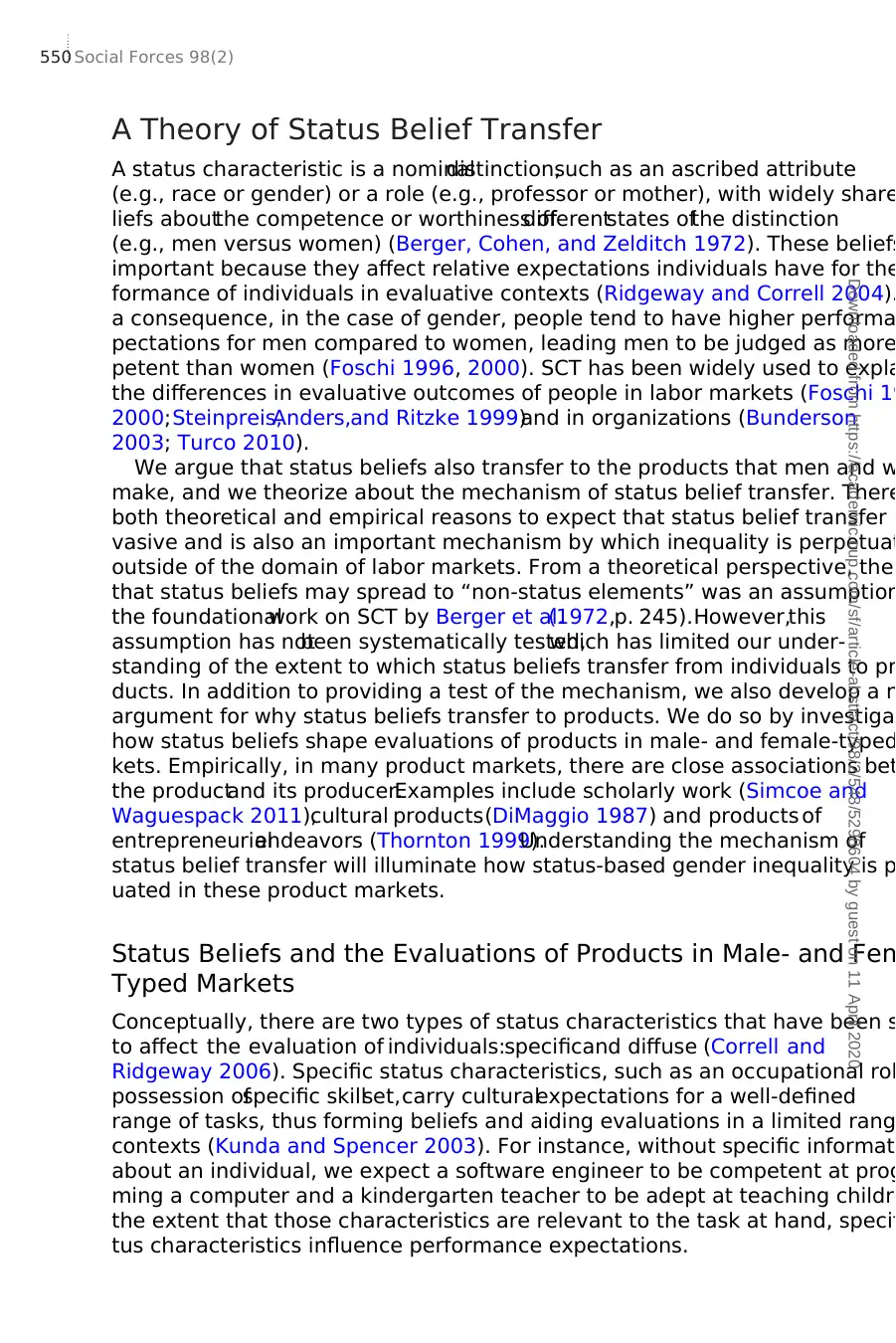
A status characteristic is a nominaldistinction,such as an ascribed attribute
(e.g., race or gender) or a role (e.g., professor or mother), with widely share
liefs aboutthe competence or worthiness ofdifferentstates ofthe distinction
(e.g., men versus women) (Berger, Cohen, and Zelditch 1972). These beliefs
important because they affect relative expectations individuals have for the
formance of individuals in evaluative contexts (Ridgeway and Correll 2004).
a consequence, in the case of gender, people tend to have higher performa
pectations for men compared to women, leading men to be judged as more
petent than women (Foschi 1996, 2000). SCT has been widely used to expla
the differences in evaluative outcomes of people in labor markets (Foschi 19
2000;Steinpreis,Anders,and Ritzke 1999)and in organizations (Bunderson
2003; Turco 2010).
We argue that status beliefs also transfer to the products that men and w
make, and we theorize about the mechanism of status belief transfer. There
both theoretical and empirical reasons to expect that status belief transfer i
vasive and is also an important mechanism by which inequality is perpetuat
outside of the domain of labor markets. From a theoretical perspective, the
that status beliefs may spread to “non-status elements” was an assumption
the foundationalwork on SCT by Berger et al.(1972,p. 245).However,this
assumption has notbeen systematically tested,which has limited our under-
standing of the extent to which status beliefs transfer from individuals to pr
ducts. In addition to providing a test of the mechanism, we also develop a n
argument for why status beliefs transfer to products. We do so by investigat
how status beliefs shape evaluations of products in male- and female-typed
kets. Empirically, in many product markets, there are close associations bet
the productand its producer.Examples include scholarly work (Simcoe and
Waguespack 2011),cultural products(DiMaggio 1987) and products of
entrepreneurialendeavors (Thornton 1999).Understanding the mechanism of
status belief transfer will illuminate how status-based gender inequality is p
uated in these product markets.
Status Beliefs and the Evaluations of Products in Male- and Fem
Typed Markets
Conceptually, there are two types of status characteristics that have been s
to affect the evaluation of individuals:specificand diffuse (Correll and
Ridgeway 2006). Specific status characteristics, such as an occupational rol
possession ofspecific skillset,carry culturalexpectations for a well-defined
range of tasks, thus forming beliefs and aiding evaluations in a limited rang
contexts (Kunda and Spencer 2003). For instance, without specific informat
about an individual, we expect a software engineer to be competent at prog
ming a computer and a kindergarten teacher to be adept at teaching childre
the extent that those characteristics are relevant to the task at hand, specifi
tus characteristics influence performance expectations.
A Theory of Status Belief Transfer
Social Forces 98(2)550
Downloaded from https://academic.oup.com/sf/article-abstract/98/2/548/5298604 by guest on 11 April 2020
(e.g., race or gender) or a role (e.g., professor or mother), with widely share
liefs aboutthe competence or worthiness ofdifferentstates ofthe distinction
(e.g., men versus women) (Berger, Cohen, and Zelditch 1972). These beliefs
important because they affect relative expectations individuals have for the
formance of individuals in evaluative contexts (Ridgeway and Correll 2004).
a consequence, in the case of gender, people tend to have higher performa
pectations for men compared to women, leading men to be judged as more
petent than women (Foschi 1996, 2000). SCT has been widely used to expla
the differences in evaluative outcomes of people in labor markets (Foschi 19
2000;Steinpreis,Anders,and Ritzke 1999)and in organizations (Bunderson
2003; Turco 2010).
We argue that status beliefs also transfer to the products that men and w
make, and we theorize about the mechanism of status belief transfer. There
both theoretical and empirical reasons to expect that status belief transfer i
vasive and is also an important mechanism by which inequality is perpetuat
outside of the domain of labor markets. From a theoretical perspective, the
that status beliefs may spread to “non-status elements” was an assumption
the foundationalwork on SCT by Berger et al.(1972,p. 245).However,this
assumption has notbeen systematically tested,which has limited our under-
standing of the extent to which status beliefs transfer from individuals to pr
ducts. In addition to providing a test of the mechanism, we also develop a n
argument for why status beliefs transfer to products. We do so by investigat
how status beliefs shape evaluations of products in male- and female-typed
kets. Empirically, in many product markets, there are close associations bet
the productand its producer.Examples include scholarly work (Simcoe and
Waguespack 2011),cultural products(DiMaggio 1987) and products of
entrepreneurialendeavors (Thornton 1999).Understanding the mechanism of
status belief transfer will illuminate how status-based gender inequality is p
uated in these product markets.
Status Beliefs and the Evaluations of Products in Male- and Fem
Typed Markets
Conceptually, there are two types of status characteristics that have been s
to affect the evaluation of individuals:specificand diffuse (Correll and
Ridgeway 2006). Specific status characteristics, such as an occupational rol
possession ofspecific skillset,carry culturalexpectations for a well-defined
range of tasks, thus forming beliefs and aiding evaluations in a limited rang
contexts (Kunda and Spencer 2003). For instance, without specific informat
about an individual, we expect a software engineer to be competent at prog
ming a computer and a kindergarten teacher to be adept at teaching childre
the extent that those characteristics are relevant to the task at hand, specifi
tus characteristics influence performance expectations.
A Theory of Status Belief Transfer
Social Forces 98(2)550
Downloaded from https://academic.oup.com/sf/article-abstract/98/2/548/5298604 by guest on 11 April 2020
⊘ This is a preview!⊘
Do you want full access?
Subscribe today to unlock all pages.

Trusted by 1+ million students worldwide
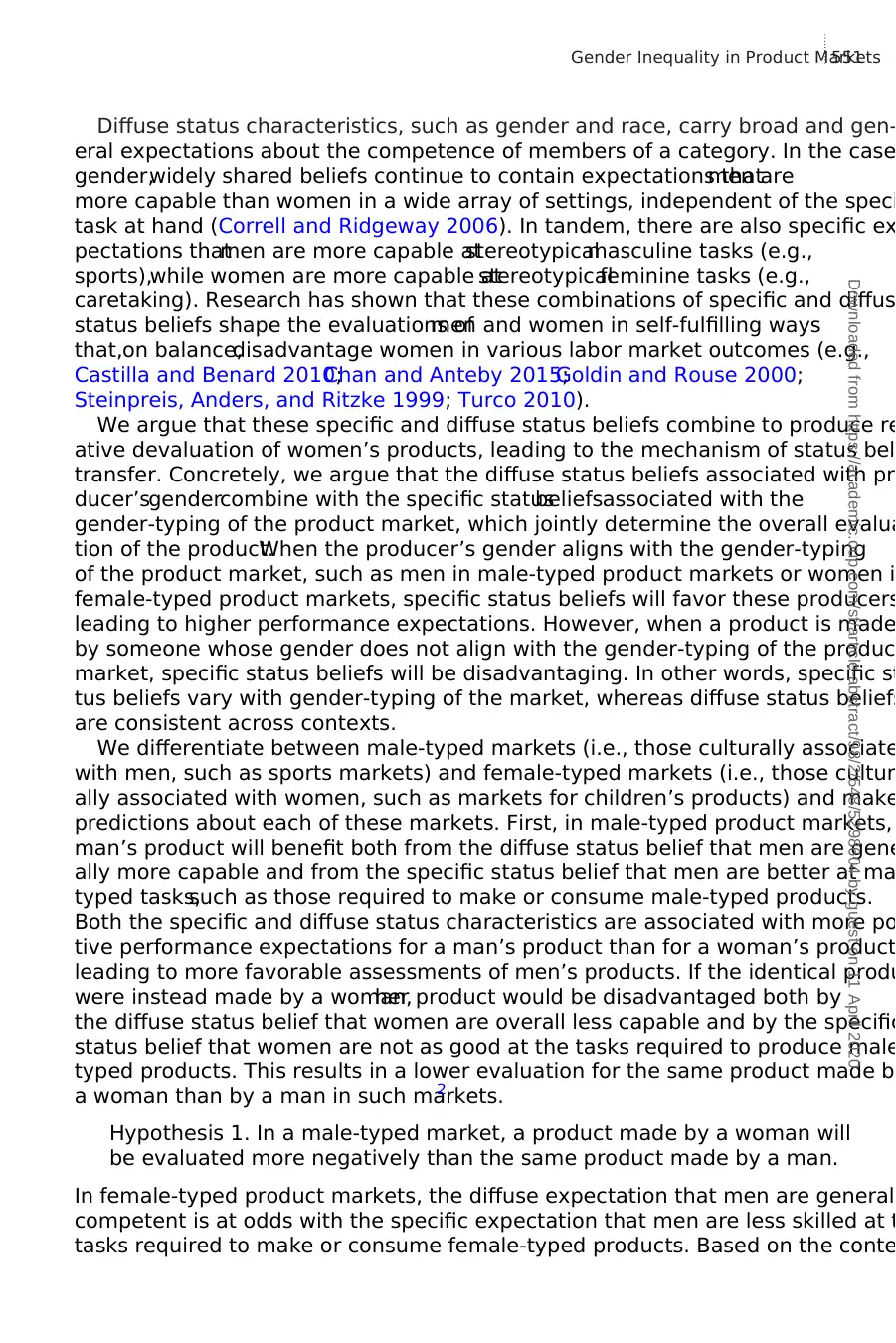
eral expectations about the competence of members of a category. In the case
gender,widely shared beliefs continue to contain expectations thatmen are
more capable than women in a wide array of settings, independent of the speci
task at hand (Correll and Ridgeway 2006). In tandem, there are also specific ex
pectations thatmen are more capable atstereotypicalmasculine tasks (e.g.,
sports),while women are more capable atstereotypicalfeminine tasks (e.g.,
caretaking). Research has shown that these combinations of specific and diffus
status beliefs shape the evaluations ofmen and women in self-fulfilling ways
that,on balance,disadvantage women in various labor market outcomes (e.g.,
Castilla and Benard 2010;Chan and Anteby 2015;Goldin and Rouse 2000;
Steinpreis, Anders, and Ritzke 1999; Turco 2010).
We argue that these specific and diffuse status beliefs combine to produce re
ative devaluation of women’s products, leading to the mechanism of status bel
transfer. Concretely, we argue that the diffuse status beliefs associated with pro
ducer’sgendercombine with the specific statusbeliefsassociated with the
gender-typing of the product market, which jointly determine the overall evalua
tion of the product.When the producer’s gender aligns with the gender-typing
of the product market, such as men in male-typed product markets or women i
female-typed product markets, specific status beliefs will favor these producers
leading to higher performance expectations. However, when a product is made
by someone whose gender does not align with the gender-typing of the produc
market, specific status beliefs will be disadvantaging. In other words, specific st
tus beliefs vary with gender-typing of the market, whereas diffuse status beliefs
are consistent across contexts.
We differentiate between male-typed markets (i.e., those culturally associate
with men, such as sports markets) and female-typed markets (i.e., those cultur
ally associated with women, such as markets for children’s products) and make
predictions about each of these markets. First, in male-typed product markets,
man’s product will benefit both from the diffuse status belief that men are gene
ally more capable and from the specific status belief that men are better at ma
typed tasks,such as those required to make or consume male-typed products.
Both the specific and diffuse status characteristics are associated with more po
tive performance expectations for a man’s product than for a woman’s product
leading to more favorable assessments of men’s products. If the identical produ
were instead made by a woman,her product would be disadvantaged both by
the diffuse status belief that women are overall less capable and by the specific
status belief that women are not as good at the tasks required to produce male
typed products. This results in a lower evaluation for the same product made by
a woman than by a man in such markets.2
Hypothesis 1. In a male-typed market, a product made by a woman will
be evaluated more negatively than the same product made by a man.
In female-typed product markets, the diffuse expectation that men are generall
competent is at odds with the specific expectation that men are less skilled at t
tasks required to make or consume female-typed products. Based on the conte
Diffuse status characteristics, such as gender and race, carry broad and gen-
Gender Inequality in Product Markets551 Downloaded from https://academic.oup.com/sf/article-abstract/98/2/548/5298604 by guest on 11 April 2020
gender,widely shared beliefs continue to contain expectations thatmen are
more capable than women in a wide array of settings, independent of the speci
task at hand (Correll and Ridgeway 2006). In tandem, there are also specific ex
pectations thatmen are more capable atstereotypicalmasculine tasks (e.g.,
sports),while women are more capable atstereotypicalfeminine tasks (e.g.,
caretaking). Research has shown that these combinations of specific and diffus
status beliefs shape the evaluations ofmen and women in self-fulfilling ways
that,on balance,disadvantage women in various labor market outcomes (e.g.,
Castilla and Benard 2010;Chan and Anteby 2015;Goldin and Rouse 2000;
Steinpreis, Anders, and Ritzke 1999; Turco 2010).
We argue that these specific and diffuse status beliefs combine to produce re
ative devaluation of women’s products, leading to the mechanism of status bel
transfer. Concretely, we argue that the diffuse status beliefs associated with pro
ducer’sgendercombine with the specific statusbeliefsassociated with the
gender-typing of the product market, which jointly determine the overall evalua
tion of the product.When the producer’s gender aligns with the gender-typing
of the product market, such as men in male-typed product markets or women i
female-typed product markets, specific status beliefs will favor these producers
leading to higher performance expectations. However, when a product is made
by someone whose gender does not align with the gender-typing of the produc
market, specific status beliefs will be disadvantaging. In other words, specific st
tus beliefs vary with gender-typing of the market, whereas diffuse status beliefs
are consistent across contexts.
We differentiate between male-typed markets (i.e., those culturally associate
with men, such as sports markets) and female-typed markets (i.e., those cultur
ally associated with women, such as markets for children’s products) and make
predictions about each of these markets. First, in male-typed product markets,
man’s product will benefit both from the diffuse status belief that men are gene
ally more capable and from the specific status belief that men are better at ma
typed tasks,such as those required to make or consume male-typed products.
Both the specific and diffuse status characteristics are associated with more po
tive performance expectations for a man’s product than for a woman’s product
leading to more favorable assessments of men’s products. If the identical produ
were instead made by a woman,her product would be disadvantaged both by
the diffuse status belief that women are overall less capable and by the specific
status belief that women are not as good at the tasks required to produce male
typed products. This results in a lower evaluation for the same product made by
a woman than by a man in such markets.2
Hypothesis 1. In a male-typed market, a product made by a woman will
be evaluated more negatively than the same product made by a man.
In female-typed product markets, the diffuse expectation that men are generall
competent is at odds with the specific expectation that men are less skilled at t
tasks required to make or consume female-typed products. Based on the conte
Diffuse status characteristics, such as gender and race, carry broad and gen-
Gender Inequality in Product Markets551 Downloaded from https://academic.oup.com/sf/article-abstract/98/2/548/5298604 by guest on 11 April 2020
Paraphrase This Document
Need a fresh take? Get an instant paraphrase of this document with our AI Paraphraser
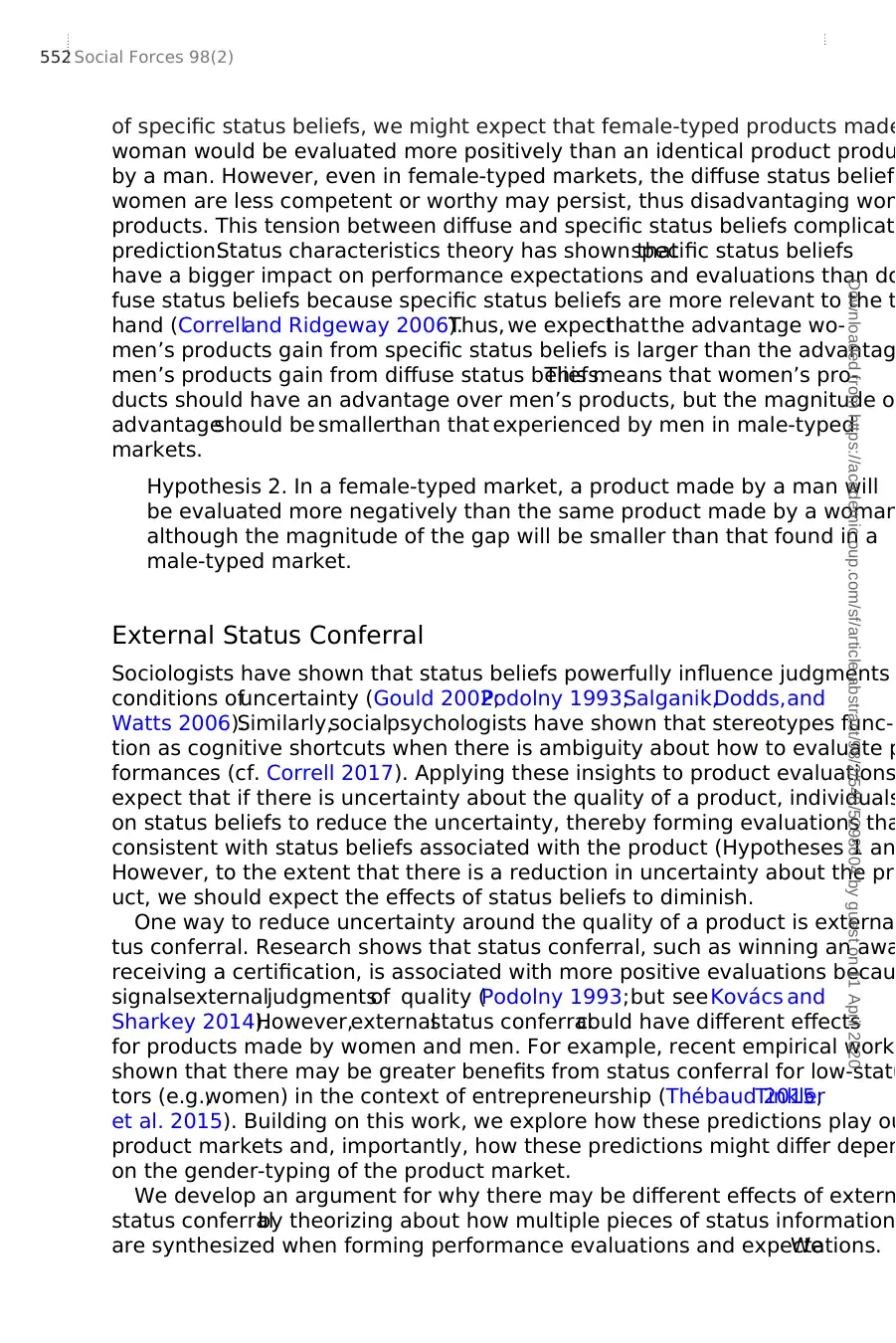
woman would be evaluated more positively than an identical product produ
by a man. However, even in female-typed markets, the diffuse status belief
women are less competent or worthy may persist, thus disadvantaging wom
products. This tension between diffuse and specific status beliefs complicate
prediction.Status characteristics theory has shown thatspecific status beliefs
have a bigger impact on performance expectations and evaluations than do
fuse status beliefs because specific status beliefs are more relevant to the t
hand (Correlland Ridgeway 2006).Thus, we expectthatthe advantage wo-
men’s products gain from specific status beliefs is larger than the advantag
men’s products gain from diffuse status beliefs.This means that women’s pro-
ducts should have an advantage over men’s products, but the magnitude of
advantageshould be smallerthan that experienced by men in male-typed
markets.
Hypothesis 2. In a female-typed market, a product made by a man will
be evaluated more negatively than the same product made by a woman
although the magnitude of the gap will be smaller than that found in a
male-typed market.
External Status Conferral
Sociologists have shown that status beliefs powerfully influence judgments
conditions ofuncertainty (Gould 2002;Podolny 1993;Salganik,Dodds,and
Watts 2006).Similarly,socialpsychologists have shown that stereotypes func-
tion as cognitive shortcuts when there is ambiguity about how to evaluate p
formances (cf. Correll 2017). Applying these insights to product evaluations
expect that if there is uncertainty about the quality of a product, individuals
on status beliefs to reduce the uncertainty, thereby forming evaluations tha
consistent with status beliefs associated with the product (Hypotheses 1 an
However, to the extent that there is a reduction in uncertainty about the pro
uct, we should expect the effects of status beliefs to diminish.
One way to reduce uncertainty around the quality of a product is external
tus conferral. Research shows that status conferral, such as winning an awa
receiving a certification, is associated with more positive evaluations becau
signalsexternaljudgmentsof quality (Podolny 1993;but seeKovács and
Sharkey 2014).However,externalstatus conferralcould have different effects
for products made by women and men. For example, recent empirical work
shown that there may be greater benefits from status conferral for low-statu
tors (e.g.,women) in the context of entrepreneurship (Thébaud 2015;Tinkler
et al. 2015). Building on this work, we explore how these predictions play ou
product markets and, importantly, how these predictions might differ depen
on the gender-typing of the product market.
We develop an argument for why there may be different effects of extern
status conferralby theorizing about how multiple pieces of status information
are synthesized when forming performance evaluations and expectations.We
of specific status beliefs, we might expect that female-typed products made
Social Forces 98(2)552
Downloaded from https://academic.oup.com/sf/article-abstract/98/2/548/5298604 by guest on 11 April 2020
by a man. However, even in female-typed markets, the diffuse status belief
women are less competent or worthy may persist, thus disadvantaging wom
products. This tension between diffuse and specific status beliefs complicate
prediction.Status characteristics theory has shown thatspecific status beliefs
have a bigger impact on performance expectations and evaluations than do
fuse status beliefs because specific status beliefs are more relevant to the t
hand (Correlland Ridgeway 2006).Thus, we expectthatthe advantage wo-
men’s products gain from specific status beliefs is larger than the advantag
men’s products gain from diffuse status beliefs.This means that women’s pro-
ducts should have an advantage over men’s products, but the magnitude of
advantageshould be smallerthan that experienced by men in male-typed
markets.
Hypothesis 2. In a female-typed market, a product made by a man will
be evaluated more negatively than the same product made by a woman
although the magnitude of the gap will be smaller than that found in a
male-typed market.
External Status Conferral
Sociologists have shown that status beliefs powerfully influence judgments
conditions ofuncertainty (Gould 2002;Podolny 1993;Salganik,Dodds,and
Watts 2006).Similarly,socialpsychologists have shown that stereotypes func-
tion as cognitive shortcuts when there is ambiguity about how to evaluate p
formances (cf. Correll 2017). Applying these insights to product evaluations
expect that if there is uncertainty about the quality of a product, individuals
on status beliefs to reduce the uncertainty, thereby forming evaluations tha
consistent with status beliefs associated with the product (Hypotheses 1 an
However, to the extent that there is a reduction in uncertainty about the pro
uct, we should expect the effects of status beliefs to diminish.
One way to reduce uncertainty around the quality of a product is external
tus conferral. Research shows that status conferral, such as winning an awa
receiving a certification, is associated with more positive evaluations becau
signalsexternaljudgmentsof quality (Podolny 1993;but seeKovács and
Sharkey 2014).However,externalstatus conferralcould have different effects
for products made by women and men. For example, recent empirical work
shown that there may be greater benefits from status conferral for low-statu
tors (e.g.,women) in the context of entrepreneurship (Thébaud 2015;Tinkler
et al. 2015). Building on this work, we explore how these predictions play ou
product markets and, importantly, how these predictions might differ depen
on the gender-typing of the product market.
We develop an argument for why there may be different effects of extern
status conferralby theorizing about how multiple pieces of status information
are synthesized when forming performance evaluations and expectations.We
of specific status beliefs, we might expect that female-typed products made
Social Forces 98(2)552
Downloaded from https://academic.oup.com/sf/article-abstract/98/2/548/5298604 by guest on 11 April 2020
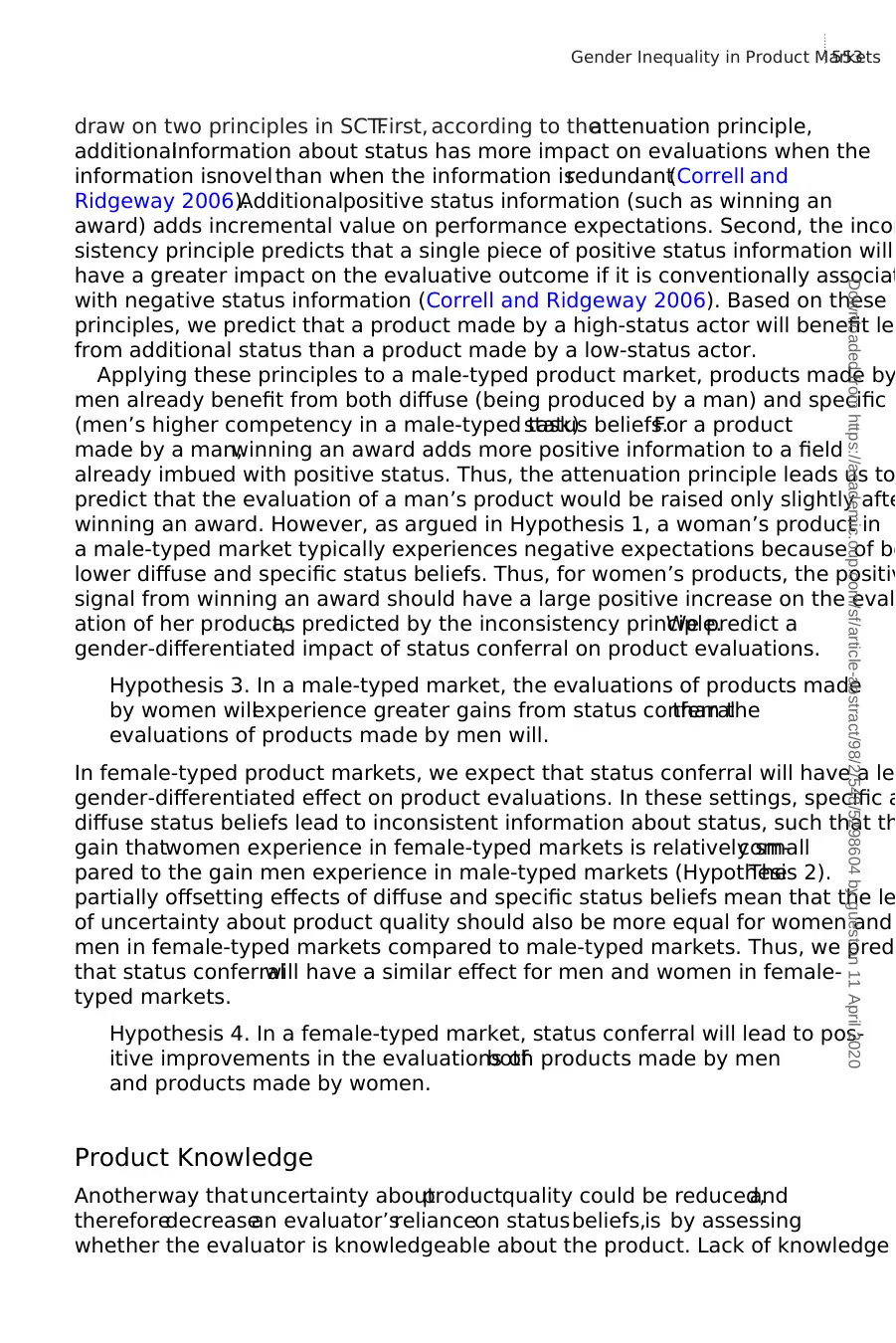
attenuation principle,
additionalinformation about status has more impact on evaluations when the
information isnovel than when the information isredundant(Correll and
Ridgeway 2006).Additionalpositive status information (such as winning an
award) adds incremental value on performance expectations. Second, the incon
sistency principle predicts that a single piece of positive status information will
have a greater impact on the evaluative outcome if it is conventionally associat
with negative status information (Correll and Ridgeway 2006). Based on these
principles, we predict that a product made by a high-status actor will benefit les
from additional status than a product made by a low-status actor.
Applying these principles to a male-typed product market, products made by
men already benefit from both diffuse (being produced by a man) and specific
(men’s higher competency in a male-typed task)status beliefs.For a product
made by a man,winning an award adds more positive information to a field
already imbued with positive status. Thus, the attenuation principle leads us to
predict that the evaluation of a man’s product would be raised only slightly afte
winning an award. However, as argued in Hypothesis 1, a woman’s product in
a male-typed market typically experiences negative expectations because of bo
lower diffuse and specific status beliefs. Thus, for women’s products, the positiv
signal from winning an award should have a large positive increase on the eval
ation of her product,as predicted by the inconsistency principle.We predict a
gender-differentiated impact of status conferral on product evaluations.
Hypothesis 3. In a male-typed market, the evaluations of products made
by women willexperience greater gains from status conferralthan the
evaluations of products made by men will.
In female-typed product markets, we expect that status conferral will have a les
gender-differentiated effect on product evaluations. In these settings, specific a
diffuse status beliefs lead to inconsistent information about status, such that th
gain thatwomen experience in female-typed markets is relatively smallcom-
pared to the gain men experience in male-typed markets (Hypothesis 2).The
partially offsetting effects of diffuse and specific status beliefs mean that the le
of uncertainty about product quality should also be more equal for women and
men in female-typed markets compared to male-typed markets. Thus, we predi
that status conferralwill have a similar effect for men and women in female-
typed markets.
Hypothesis 4. In a female-typed market, status conferral will lead to pos-
itive improvements in the evaluations ofboth products made by men
and products made by women.
Product Knowledge
Anotherway thatuncertainty aboutproductquality could be reduced,and
thereforedecreasean evaluator’srelianceon statusbeliefs,is by assessing
whether the evaluator is knowledgeable about the product. Lack of knowledge
draw on two principles in SCT.First, according to the
Gender Inequality in Product Markets553 Downloaded from https://academic.oup.com/sf/article-abstract/98/2/548/5298604 by guest on 11 April 2020
additionalinformation about status has more impact on evaluations when the
information isnovel than when the information isredundant(Correll and
Ridgeway 2006).Additionalpositive status information (such as winning an
award) adds incremental value on performance expectations. Second, the incon
sistency principle predicts that a single piece of positive status information will
have a greater impact on the evaluative outcome if it is conventionally associat
with negative status information (Correll and Ridgeway 2006). Based on these
principles, we predict that a product made by a high-status actor will benefit les
from additional status than a product made by a low-status actor.
Applying these principles to a male-typed product market, products made by
men already benefit from both diffuse (being produced by a man) and specific
(men’s higher competency in a male-typed task)status beliefs.For a product
made by a man,winning an award adds more positive information to a field
already imbued with positive status. Thus, the attenuation principle leads us to
predict that the evaluation of a man’s product would be raised only slightly afte
winning an award. However, as argued in Hypothesis 1, a woman’s product in
a male-typed market typically experiences negative expectations because of bo
lower diffuse and specific status beliefs. Thus, for women’s products, the positiv
signal from winning an award should have a large positive increase on the eval
ation of her product,as predicted by the inconsistency principle.We predict a
gender-differentiated impact of status conferral on product evaluations.
Hypothesis 3. In a male-typed market, the evaluations of products made
by women willexperience greater gains from status conferralthan the
evaluations of products made by men will.
In female-typed product markets, we expect that status conferral will have a les
gender-differentiated effect on product evaluations. In these settings, specific a
diffuse status beliefs lead to inconsistent information about status, such that th
gain thatwomen experience in female-typed markets is relatively smallcom-
pared to the gain men experience in male-typed markets (Hypothesis 2).The
partially offsetting effects of diffuse and specific status beliefs mean that the le
of uncertainty about product quality should also be more equal for women and
men in female-typed markets compared to male-typed markets. Thus, we predi
that status conferralwill have a similar effect for men and women in female-
typed markets.
Hypothesis 4. In a female-typed market, status conferral will lead to pos-
itive improvements in the evaluations ofboth products made by men
and products made by women.
Product Knowledge
Anotherway thatuncertainty aboutproductquality could be reduced,and
thereforedecreasean evaluator’srelianceon statusbeliefs,is by assessing
whether the evaluator is knowledgeable about the product. Lack of knowledge
draw on two principles in SCT.First, according to the
Gender Inequality in Product Markets553 Downloaded from https://academic.oup.com/sf/article-abstract/98/2/548/5298604 by guest on 11 April 2020
⊘ This is a preview!⊘
Do you want full access?
Subscribe today to unlock all pages.

Trusted by 1+ million students worldwide
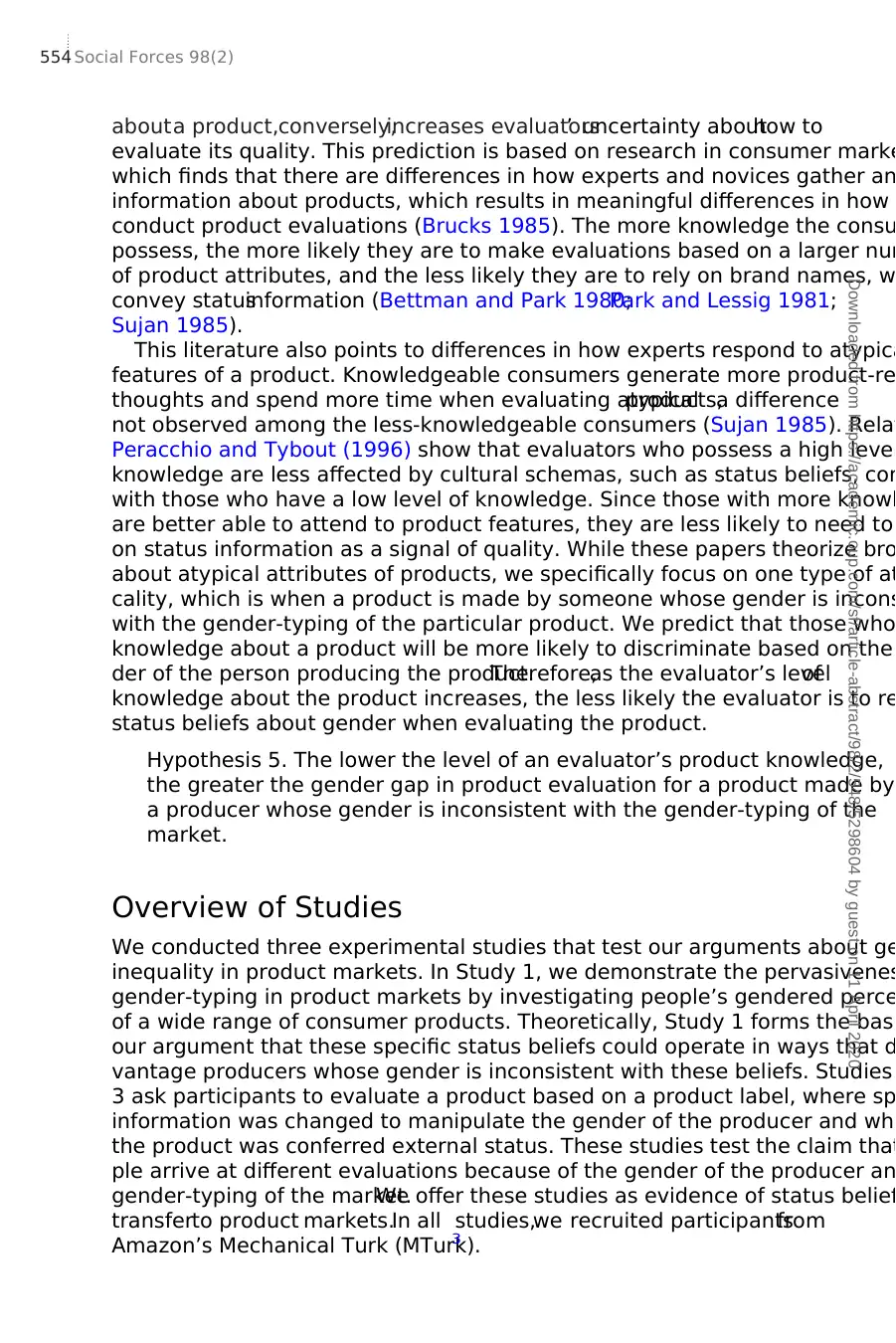
’ uncertainty abouthow to
evaluate its quality. This prediction is based on research in consumer marke
which finds that there are differences in how experts and novices gather an
information about products, which results in meaningful differences in how
conduct product evaluations (Brucks 1985). The more knowledge the consu
possess, the more likely they are to make evaluations based on a larger num
of product attributes, and the less likely they are to rely on brand names, w
convey statusinformation (Bettman and Park 1980;Park and Lessig 1981;
Sujan 1985).
This literature also points to differences in how experts respond to atypica
features of a product. Knowledgeable consumers generate more product-re
thoughts and spend more time when evaluating atypicalproducts,a difference
not observed among the less-knowledgeable consumers (Sujan 1985). Relat
Peracchio and Tybout (1996) show that evaluators who possess a high level
knowledge are less affected by cultural schemas, such as status beliefs, com
with those who have a low level of knowledge. Since those with more knowl
are better able to attend to product features, they are less likely to need to
on status information as a signal of quality. While these papers theorize bro
about atypical attributes of products, we specifically focus on one type of at
cality, which is when a product is made by someone whose gender is incons
with the gender-typing of the particular product. We predict that those who
knowledge about a product will be more likely to discriminate based on the
der of the person producing the product.Therefore,as the evaluator’s levelof
knowledge about the product increases, the less likely the evaluator is to re
status beliefs about gender when evaluating the product.
Hypothesis 5. The lower the level of an evaluator’s product knowledge,
the greater the gender gap in product evaluation for a product made by
a producer whose gender is inconsistent with the gender-typing of the
market.
Overview of Studies
We conducted three experimental studies that test our arguments about ge
inequality in product markets. In Study 1, we demonstrate the pervasivenes
gender-typing in product markets by investigating people’s gendered perce
of a wide range of consumer products. Theoretically, Study 1 forms the basi
our argument that these specific status beliefs could operate in ways that d
vantage producers whose gender is inconsistent with these beliefs. Studies
3 ask participants to evaluate a product based on a product label, where sp
information was changed to manipulate the gender of the producer and whe
the product was conferred external status. These studies test the claim that
ple arrive at different evaluations because of the gender of the producer an
gender-typing of the market.We offer these studies as evidence of status belief
transferto product markets.In all studies,we recruited participantsfrom
Amazon’s Mechanical Turk (MTurk).3
abouta product,conversely,increases evaluators
Social Forces 98(2)554
Downloaded from https://academic.oup.com/sf/article-abstract/98/2/548/5298604 by guest on 11 April 2020
evaluate its quality. This prediction is based on research in consumer marke
which finds that there are differences in how experts and novices gather an
information about products, which results in meaningful differences in how
conduct product evaluations (Brucks 1985). The more knowledge the consu
possess, the more likely they are to make evaluations based on a larger num
of product attributes, and the less likely they are to rely on brand names, w
convey statusinformation (Bettman and Park 1980;Park and Lessig 1981;
Sujan 1985).
This literature also points to differences in how experts respond to atypica
features of a product. Knowledgeable consumers generate more product-re
thoughts and spend more time when evaluating atypicalproducts,a difference
not observed among the less-knowledgeable consumers (Sujan 1985). Relat
Peracchio and Tybout (1996) show that evaluators who possess a high level
knowledge are less affected by cultural schemas, such as status beliefs, com
with those who have a low level of knowledge. Since those with more knowl
are better able to attend to product features, they are less likely to need to
on status information as a signal of quality. While these papers theorize bro
about atypical attributes of products, we specifically focus on one type of at
cality, which is when a product is made by someone whose gender is incons
with the gender-typing of the particular product. We predict that those who
knowledge about a product will be more likely to discriminate based on the
der of the person producing the product.Therefore,as the evaluator’s levelof
knowledge about the product increases, the less likely the evaluator is to re
status beliefs about gender when evaluating the product.
Hypothesis 5. The lower the level of an evaluator’s product knowledge,
the greater the gender gap in product evaluation for a product made by
a producer whose gender is inconsistent with the gender-typing of the
market.
Overview of Studies
We conducted three experimental studies that test our arguments about ge
inequality in product markets. In Study 1, we demonstrate the pervasivenes
gender-typing in product markets by investigating people’s gendered perce
of a wide range of consumer products. Theoretically, Study 1 forms the basi
our argument that these specific status beliefs could operate in ways that d
vantage producers whose gender is inconsistent with these beliefs. Studies
3 ask participants to evaluate a product based on a product label, where sp
information was changed to manipulate the gender of the producer and whe
the product was conferred external status. These studies test the claim that
ple arrive at different evaluations because of the gender of the producer an
gender-typing of the market.We offer these studies as evidence of status belief
transferto product markets.In all studies,we recruited participantsfrom
Amazon’s Mechanical Turk (MTurk).3
abouta product,conversely,increases evaluators
Social Forces 98(2)554
Downloaded from https://academic.oup.com/sf/article-abstract/98/2/548/5298604 by guest on 11 April 2020
Paraphrase This Document
Need a fresh take? Get an instant paraphrase of this document with our AI Paraphraser
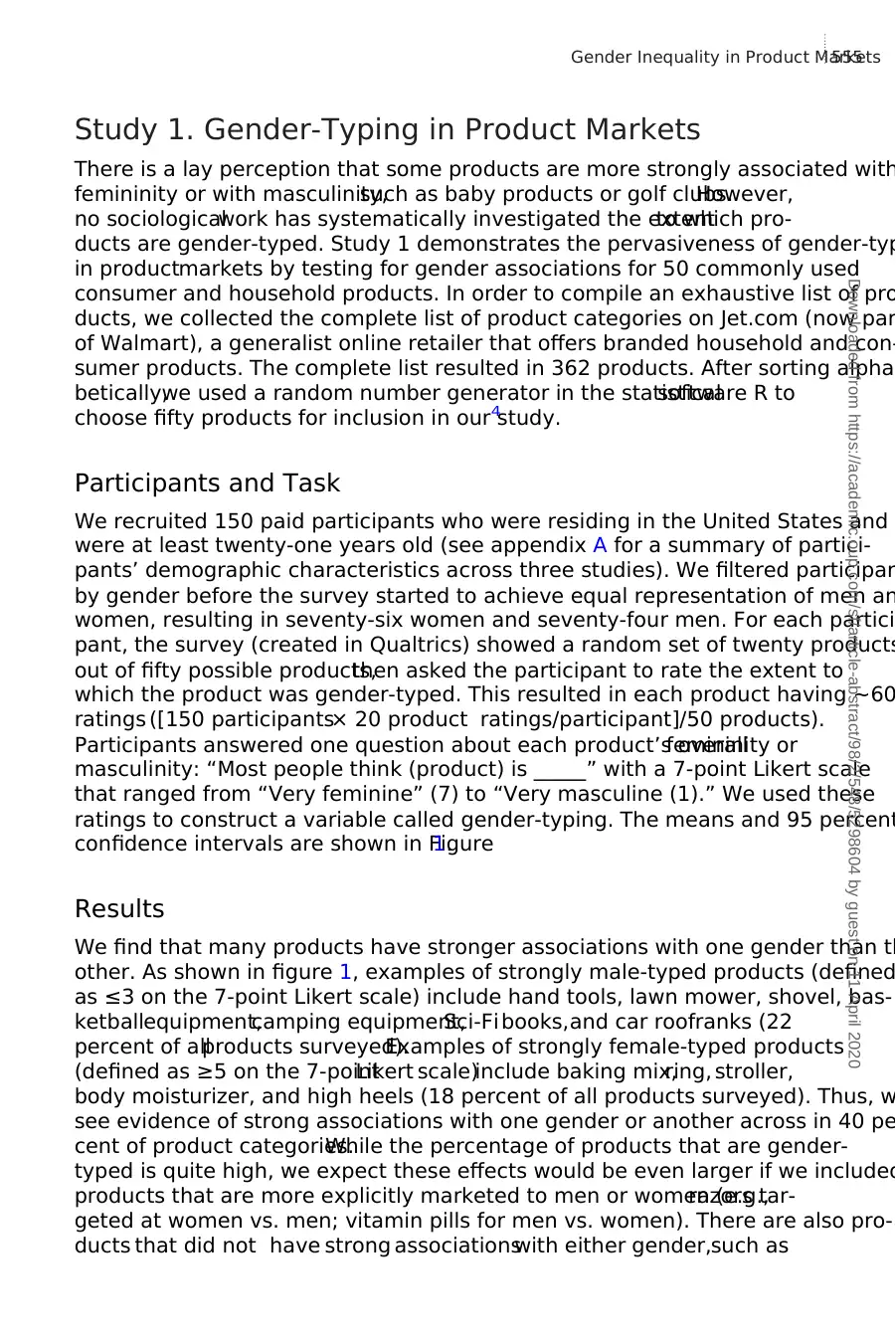
There is a lay perception that some products are more strongly associated with
femininity or with masculinity,such as baby products or golf clubs.However,
no sociologicalwork has systematically investigated the extentto which pro-
ducts are gender-typed. Study 1 demonstrates the pervasiveness of gender-typ
in productmarkets by testing for gender associations for 50 commonly used
consumer and household products. In order to compile an exhaustive list of pro
ducts, we collected the complete list of product categories on Jet.com (now par
of Walmart), a generalist online retailer that offers branded household and con-
sumer products. The complete list resulted in 362 products. After sorting alpha-
betically,we used a random number generator in the statisticalsoftware R to
choose fifty products for inclusion in our study.4
Participants and Task
We recruited 150 paid participants who were residing in the United States and
were at least twenty-one years old (see appendix A for a summary of partici-
pants’ demographic characteristics across three studies). We filtered participan
by gender before the survey started to achieve equal representation of men an
women, resulting in seventy-six women and seventy-four men. For each partici-
pant, the survey (created in Qualtrics) showed a random set of twenty products
out of fifty possible products,then asked the participant to rate the extent to
which the product was gender-typed. This resulted in each product having ~60
ratings ([150 participants× 20 product ratings/participant]/50 products).
Participants answered one question about each product’s overallfemininity or
masculinity: “Most people think (product) is _____” with a 7-point Likert scale
that ranged from “Very feminine” (7) to “Very masculine (1).” We used these
ratings to construct a variable called gender-typing. The means and 95 percent
confidence intervals are shown in Figure1.
Results
We find that many products have stronger associations with one gender than th
other. As shown in figure 1, examples of strongly male-typed products (defined
as ≤3 on the 7-point Likert scale) include hand tools, lawn mower, shovel, bas-
ketballequipment,camping equipment,Sci-Fi books,and car roofranks (22
percent of allproducts surveyed).Examples of strongly female-typed products
(defined as ≥5 on the 7-pointLikert scale)include baking mix,ring, stroller,
body moisturizer, and high heels (18 percent of all products surveyed). Thus, w
see evidence of strong associations with one gender or another across in 40 pe
cent of product categories.While the percentage of products that are gender-
typed is quite high, we expect these effects would be even larger if we included
products that are more explicitly marketed to men or women (e.g.,razors tar-
geted at women vs. men; vitamin pills for men vs. women). There are also pro-
ducts that did not have strong associationswith either gender,such as
Study 1. Gender-Typing in Product Markets
Gender Inequality in Product Markets555 Downloaded from https://academic.oup.com/sf/article-abstract/98/2/548/5298604 by guest on 11 April 2020
femininity or with masculinity,such as baby products or golf clubs.However,
no sociologicalwork has systematically investigated the extentto which pro-
ducts are gender-typed. Study 1 demonstrates the pervasiveness of gender-typ
in productmarkets by testing for gender associations for 50 commonly used
consumer and household products. In order to compile an exhaustive list of pro
ducts, we collected the complete list of product categories on Jet.com (now par
of Walmart), a generalist online retailer that offers branded household and con-
sumer products. The complete list resulted in 362 products. After sorting alpha-
betically,we used a random number generator in the statisticalsoftware R to
choose fifty products for inclusion in our study.4
Participants and Task
We recruited 150 paid participants who were residing in the United States and
were at least twenty-one years old (see appendix A for a summary of partici-
pants’ demographic characteristics across three studies). We filtered participan
by gender before the survey started to achieve equal representation of men an
women, resulting in seventy-six women and seventy-four men. For each partici-
pant, the survey (created in Qualtrics) showed a random set of twenty products
out of fifty possible products,then asked the participant to rate the extent to
which the product was gender-typed. This resulted in each product having ~60
ratings ([150 participants× 20 product ratings/participant]/50 products).
Participants answered one question about each product’s overallfemininity or
masculinity: “Most people think (product) is _____” with a 7-point Likert scale
that ranged from “Very feminine” (7) to “Very masculine (1).” We used these
ratings to construct a variable called gender-typing. The means and 95 percent
confidence intervals are shown in Figure1.
Results
We find that many products have stronger associations with one gender than th
other. As shown in figure 1, examples of strongly male-typed products (defined
as ≤3 on the 7-point Likert scale) include hand tools, lawn mower, shovel, bas-
ketballequipment,camping equipment,Sci-Fi books,and car roofranks (22
percent of allproducts surveyed).Examples of strongly female-typed products
(defined as ≥5 on the 7-pointLikert scale)include baking mix,ring, stroller,
body moisturizer, and high heels (18 percent of all products surveyed). Thus, w
see evidence of strong associations with one gender or another across in 40 pe
cent of product categories.While the percentage of products that are gender-
typed is quite high, we expect these effects would be even larger if we included
products that are more explicitly marketed to men or women (e.g.,razors tar-
geted at women vs. men; vitamin pills for men vs. women). There are also pro-
ducts that did not have strong associationswith either gender,such as
Study 1. Gender-Typing in Product Markets
Gender Inequality in Product Markets555 Downloaded from https://academic.oup.com/sf/article-abstract/98/2/548/5298604 by guest on 11 April 2020
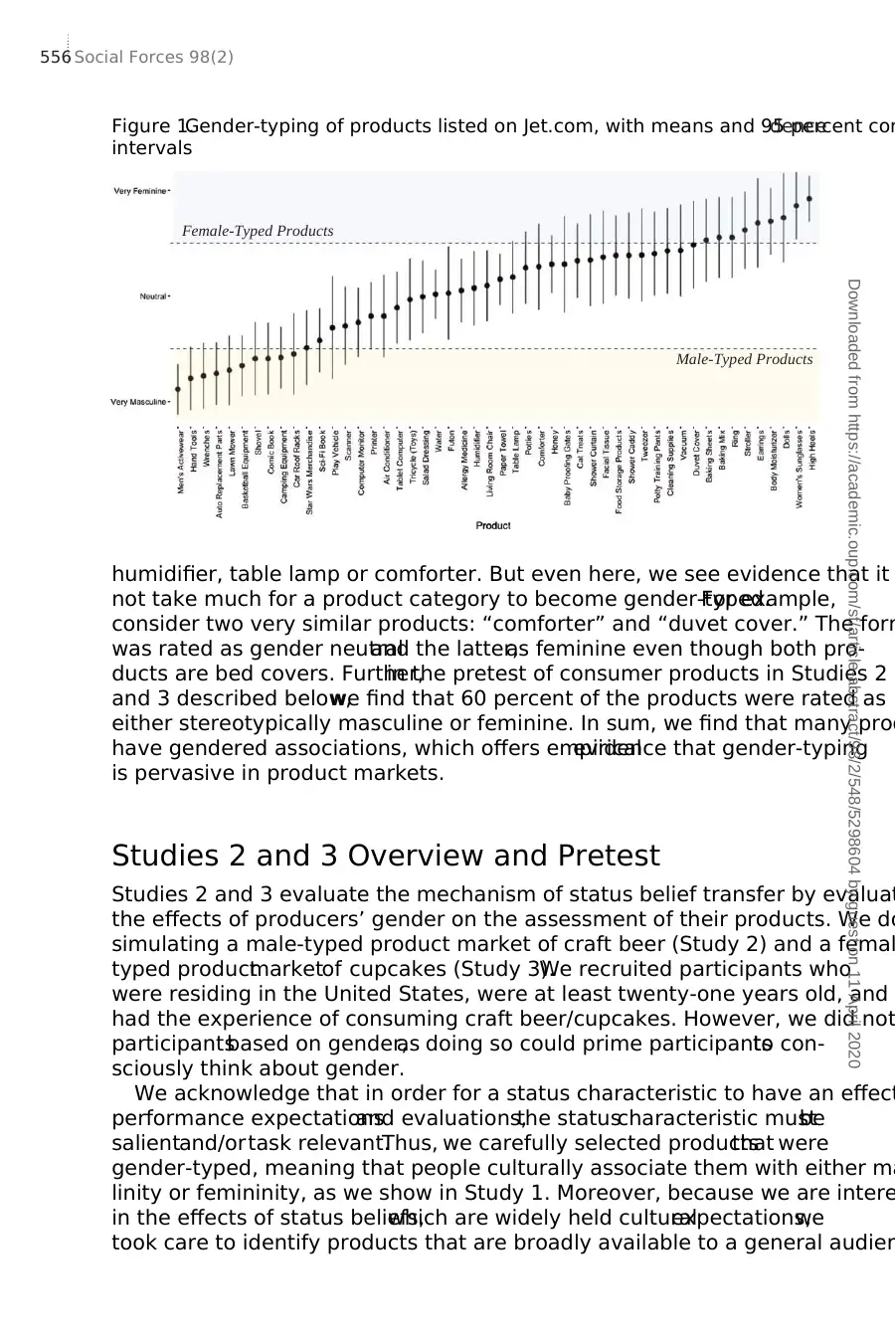
humidifier, table lamp or comforter. But even here, we see evidence that it
not take much for a product category to become gender-typed.For example,
consider two very similar products: “comforter” and “duvet cover.” The form
was rated as gender neutraland the latter,as feminine even though both pro-
ducts are bed covers. Further,in the pretest of consumer products in Studies 2
and 3 described below,we find that 60 percent of the products were rated as
either stereotypically masculine or feminine. In sum, we find that many prod
have gendered associations, which offers empiricalevidence that gender-typing
is pervasive in product markets.
Studies 2 and 3 Overview and Pretest
Studies 2 and 3 evaluate the mechanism of status belief transfer by evaluat
the effects of producers’ gender on the assessment of their products. We do
simulating a male-typed product market of craft beer (Study 2) and a femal
typed productmarketof cupcakes (Study 3).We recruited participants who
were residing in the United States, were at least twenty-one years old, and h
had the experience of consuming craft beer/cupcakes. However, we did not
participantsbased on gender,as doing so could prime participantsto con-
sciously think about gender.
We acknowledge that in order for a status characteristic to have an effect
performance expectationsand evaluations,the statuscharacteristic mustbe
salientand/ortask relevant.Thus, we carefully selected productsthat were
gender-typed, meaning that people culturally associate them with either ma
linity or femininity, as we show in Study 1. Moreover, because we are intere
in the effects of status beliefs,which are widely held culturalexpectations,we
took care to identify products that are broadly available to a general audien
Figure 1.Gender-typing of products listed on Jet.com, with means and 95 percent con
intervals
Female-Typed Products
Male-Typed Products
dence
Social Forces 98(2)556
Downloaded from https://academic.oup.com/sf/article-abstract/98/2/548/5298604 by guest on 11 April 2020
not take much for a product category to become gender-typed.For example,
consider two very similar products: “comforter” and “duvet cover.” The form
was rated as gender neutraland the latter,as feminine even though both pro-
ducts are bed covers. Further,in the pretest of consumer products in Studies 2
and 3 described below,we find that 60 percent of the products were rated as
either stereotypically masculine or feminine. In sum, we find that many prod
have gendered associations, which offers empiricalevidence that gender-typing
is pervasive in product markets.
Studies 2 and 3 Overview and Pretest
Studies 2 and 3 evaluate the mechanism of status belief transfer by evaluat
the effects of producers’ gender on the assessment of their products. We do
simulating a male-typed product market of craft beer (Study 2) and a femal
typed productmarketof cupcakes (Study 3).We recruited participants who
were residing in the United States, were at least twenty-one years old, and h
had the experience of consuming craft beer/cupcakes. However, we did not
participantsbased on gender,as doing so could prime participantsto con-
sciously think about gender.
We acknowledge that in order for a status characteristic to have an effect
performance expectationsand evaluations,the statuscharacteristic mustbe
salientand/ortask relevant.Thus, we carefully selected productsthat were
gender-typed, meaning that people culturally associate them with either ma
linity or femininity, as we show in Study 1. Moreover, because we are intere
in the effects of status beliefs,which are widely held culturalexpectations,we
took care to identify products that are broadly available to a general audien
Figure 1.Gender-typing of products listed on Jet.com, with means and 95 percent con
intervals
Female-Typed Products
Male-Typed Products
dence
Social Forces 98(2)556
Downloaded from https://academic.oup.com/sf/article-abstract/98/2/548/5298604 by guest on 11 April 2020
⊘ This is a preview!⊘
Do you want full access?
Subscribe today to unlock all pages.

Trusted by 1+ million students worldwide
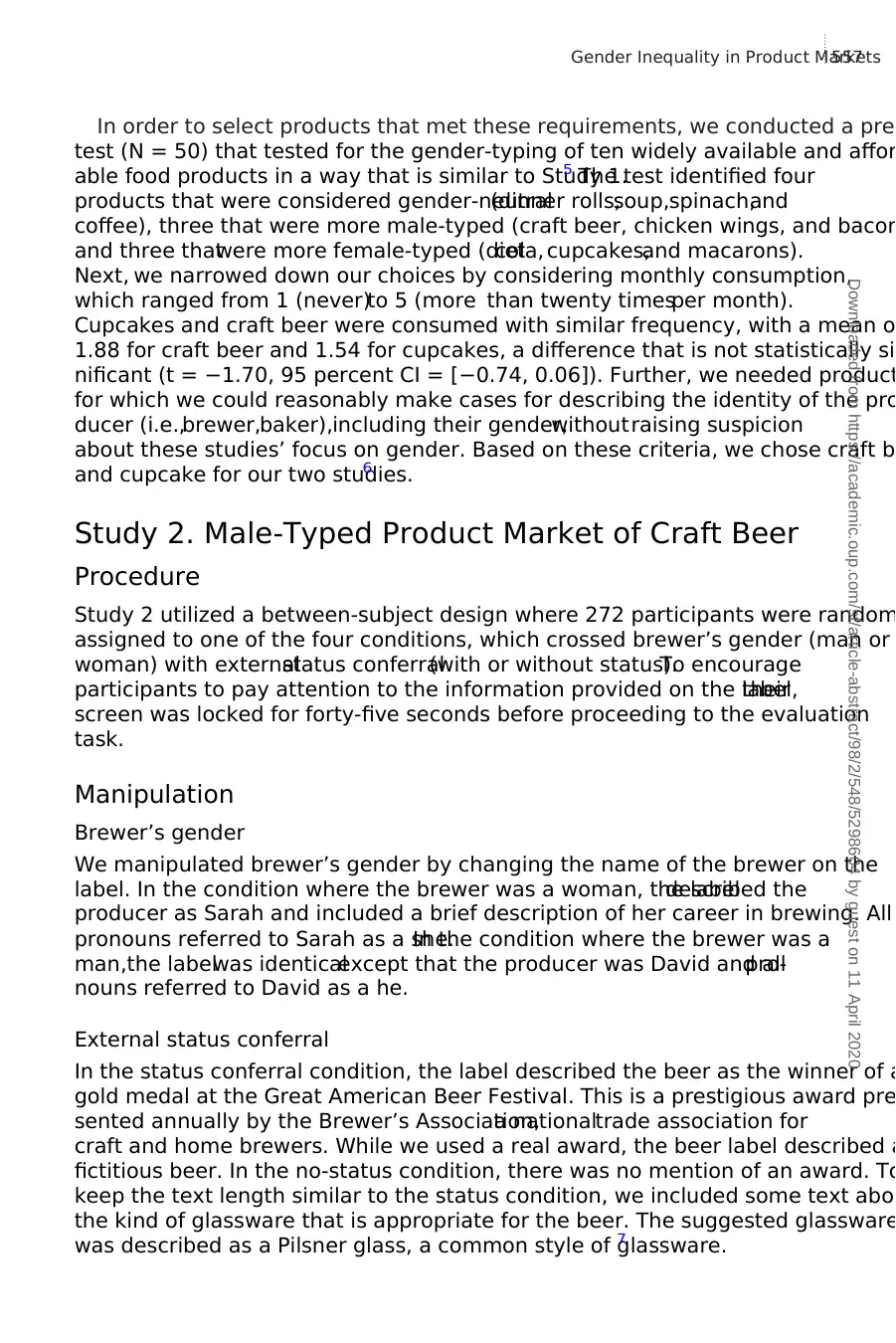
test (N = 50) that tested for the gender-typing of ten widely available and affor
able food products in a way that is similar to Study 1.5 The test identified four
products that were considered gender-neutral(dinner rolls,soup,spinach,and
coffee), three that were more male-typed (craft beer, chicken wings, and bacon
and three thatwere more female-typed (dietcola, cupcakes,and macarons).
Next, we narrowed down our choices by considering monthly consumption,
which ranged from 1 (never)to 5 (more than twenty timesper month).
Cupcakes and craft beer were consumed with similar frequency, with a mean o
1.88 for craft beer and 1.54 for cupcakes, a difference that is not statistically sig
nificant (t = −1.70, 95 percent CI = [−0.74, 0.06]). Further, we needed product
for which we could reasonably make cases for describing the identity of the pro
ducer (i.e.,brewer,baker),including their gender,withoutraising suspicion
about these studies’ focus on gender. Based on these criteria, we chose craft b
and cupcake for our two studies.6
Study 2. Male-Typed Product Market of Craft Beer
Procedure
Study 2 utilized a between-subject design where 272 participants were random
assigned to one of the four conditions, which crossed brewer’s gender (man or
woman) with externalstatus conferral(with or without status).To encourage
participants to pay attention to the information provided on the label,their
screen was locked for forty-five seconds before proceeding to the evaluation
task.
Manipulation
Brewer’s gender
We manipulated brewer’s gender by changing the name of the brewer on the
label. In the condition where the brewer was a woman, the labeldescribed the
producer as Sarah and included a brief description of her career in brewing. All
pronouns referred to Sarah as a she.In the condition where the brewer was a
man,the labelwas identicalexcept that the producer was David and allpro-
nouns referred to David as a he.
External status conferral
In the status conferral condition, the label described the beer as the winner of a
gold medal at the Great American Beer Festival. This is a prestigious award pre
sented annually by the Brewer’s Association,a nationaltrade association for
craft and home brewers. While we used a real award, the beer label described a
fictitious beer. In the no-status condition, there was no mention of an award. To
keep the text length similar to the status condition, we included some text abou
the kind of glassware that is appropriate for the beer. The suggested glassware
was described as a Pilsner glass, a common style of glassware.7
In order to select products that met these requirements, we conducted a pre-
Gender Inequality in Product Markets557 Downloaded from https://academic.oup.com/sf/article-abstract/98/2/548/5298604 by guest on 11 April 2020
able food products in a way that is similar to Study 1.5 The test identified four
products that were considered gender-neutral(dinner rolls,soup,spinach,and
coffee), three that were more male-typed (craft beer, chicken wings, and bacon
and three thatwere more female-typed (dietcola, cupcakes,and macarons).
Next, we narrowed down our choices by considering monthly consumption,
which ranged from 1 (never)to 5 (more than twenty timesper month).
Cupcakes and craft beer were consumed with similar frequency, with a mean o
1.88 for craft beer and 1.54 for cupcakes, a difference that is not statistically sig
nificant (t = −1.70, 95 percent CI = [−0.74, 0.06]). Further, we needed product
for which we could reasonably make cases for describing the identity of the pro
ducer (i.e.,brewer,baker),including their gender,withoutraising suspicion
about these studies’ focus on gender. Based on these criteria, we chose craft b
and cupcake for our two studies.6
Study 2. Male-Typed Product Market of Craft Beer
Procedure
Study 2 utilized a between-subject design where 272 participants were random
assigned to one of the four conditions, which crossed brewer’s gender (man or
woman) with externalstatus conferral(with or without status).To encourage
participants to pay attention to the information provided on the label,their
screen was locked for forty-five seconds before proceeding to the evaluation
task.
Manipulation
Brewer’s gender
We manipulated brewer’s gender by changing the name of the brewer on the
label. In the condition where the brewer was a woman, the labeldescribed the
producer as Sarah and included a brief description of her career in brewing. All
pronouns referred to Sarah as a she.In the condition where the brewer was a
man,the labelwas identicalexcept that the producer was David and allpro-
nouns referred to David as a he.
External status conferral
In the status conferral condition, the label described the beer as the winner of a
gold medal at the Great American Beer Festival. This is a prestigious award pre
sented annually by the Brewer’s Association,a nationaltrade association for
craft and home brewers. While we used a real award, the beer label described a
fictitious beer. In the no-status condition, there was no mention of an award. To
keep the text length similar to the status condition, we included some text abou
the kind of glassware that is appropriate for the beer. The suggested glassware
was described as a Pilsner glass, a common style of glassware.7
In order to select products that met these requirements, we conducted a pre-
Gender Inequality in Product Markets557 Downloaded from https://academic.oup.com/sf/article-abstract/98/2/548/5298604 by guest on 11 April 2020
Paraphrase This Document
Need a fresh take? Get an instant paraphrase of this document with our AI Paraphraser
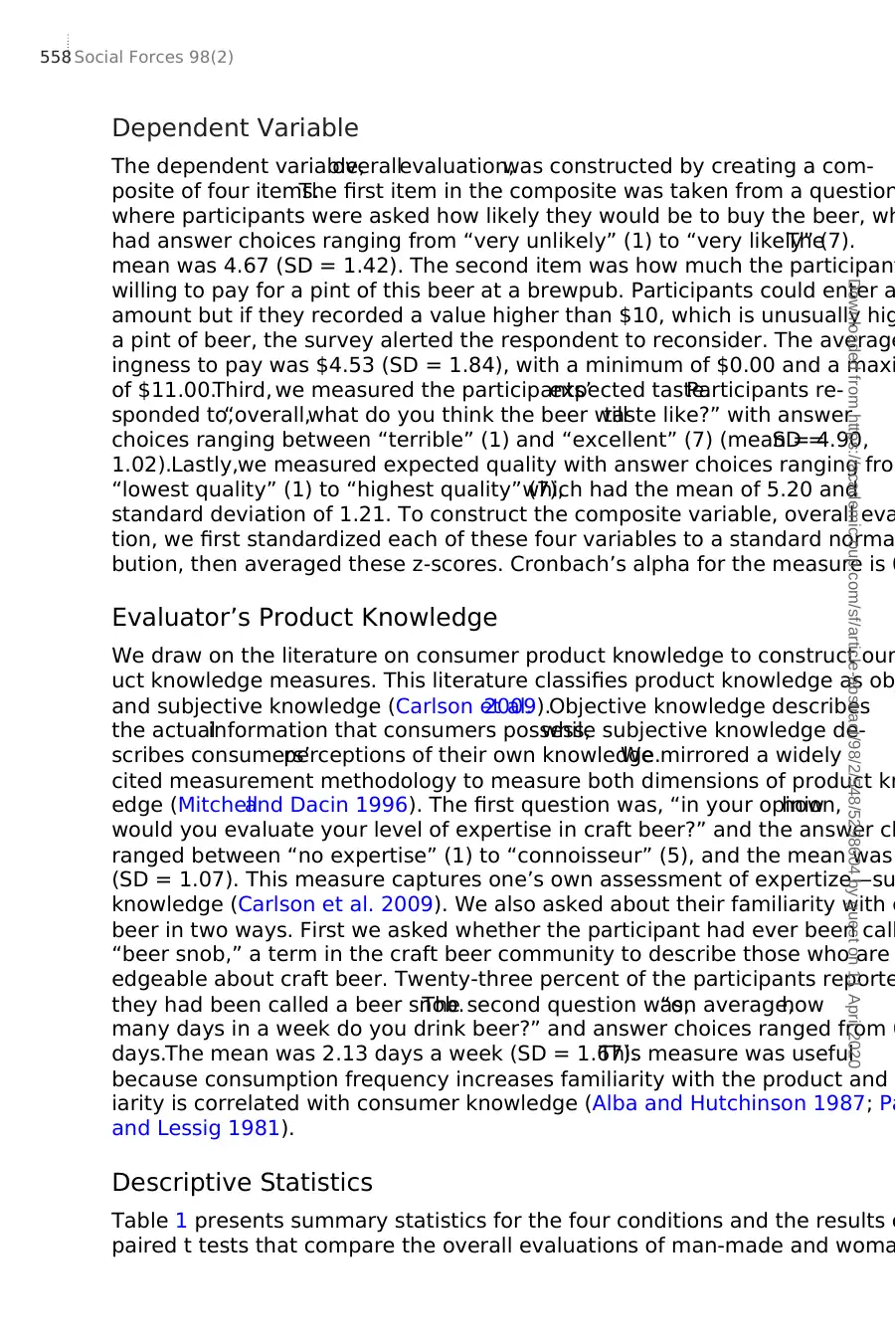
The dependent variable,overallevaluation,was constructed by creating a com-
posite of four items.The first item in the composite was taken from a question
where participants were asked how likely they would be to buy the beer, wh
had answer choices ranging from “very unlikely” (1) to “very likely” (7).The
mean was 4.67 (SD = 1.42). The second item was how much the participant
willing to pay for a pint of this beer at a brewpub. Participants could enter a
amount but if they recorded a value higher than $10, which is unusually hig
a pint of beer, the survey alerted the respondent to reconsider. The average
ingness to pay was $4.53 (SD = 1.84), with a minimum of $0.00 and a maxi
of $11.00.Third, we measured the participants’expected taste.Participants re-
sponded to,“overall,what do you think the beer willtaste like?” with answer
choices ranging between “terrible” (1) and “excellent” (7) (mean = 4.90,SD =
1.02).Lastly,we measured expected quality with answer choices ranging from
“lowest quality” (1) to “highest quality” (7),which had the mean of 5.20 and
standard deviation of 1.21. To construct the composite variable, overall eva
tion, we first standardized each of these four variables to a standard norma
bution, then averaged these z-scores. Cronbach’s alpha for the measure is 0
Evaluator’s Product Knowledge
We draw on the literature on consumer product knowledge to construct our
uct knowledge measures. This literature classifies product knowledge as ob
and subjective knowledge (Carlson et al.2009).Objective knowledge describes
the actualinformation that consumers possess,while subjective knowledge de-
scribes consumers’perceptions of their own knowledge.We mirrored a widely
cited measurement methodology to measure both dimensions of product kn
edge (Mitchelland Dacin 1996). The first question was, “in your opinion,how
would you evaluate your level of expertise in craft beer?” and the answer ch
ranged between “no expertise” (1) to “connoisseur” (5), and the mean was
(SD = 1.07). This measure captures one’s own assessment of expertize—su
knowledge (Carlson et al. 2009). We also asked about their familiarity with c
beer in two ways. First we asked whether the participant had ever been call
“beer snob,” a term in the craft beer community to describe those who are
edgeable about craft beer. Twenty-three percent of the participants reporte
they had been called a beer snob.The second question was,“on average,how
many days in a week do you drink beer?” and answer choices ranged from 0
days.The mean was 2.13 days a week (SD = 1.67).This measure was useful
because consumption frequency increases familiarity with the product and f
iarity is correlated with consumer knowledge (Alba and Hutchinson 1987; Pa
and Lessig 1981).
Descriptive Statistics
Table 1 presents summary statistics for the four conditions and the results o
paired t tests that compare the overall evaluations of man-made and woma
Dependent Variable
Social Forces 98(2)558
Downloaded from https://academic.oup.com/sf/article-abstract/98/2/548/5298604 by guest on 11 April 2020
posite of four items.The first item in the composite was taken from a question
where participants were asked how likely they would be to buy the beer, wh
had answer choices ranging from “very unlikely” (1) to “very likely” (7).The
mean was 4.67 (SD = 1.42). The second item was how much the participant
willing to pay for a pint of this beer at a brewpub. Participants could enter a
amount but if they recorded a value higher than $10, which is unusually hig
a pint of beer, the survey alerted the respondent to reconsider. The average
ingness to pay was $4.53 (SD = 1.84), with a minimum of $0.00 and a maxi
of $11.00.Third, we measured the participants’expected taste.Participants re-
sponded to,“overall,what do you think the beer willtaste like?” with answer
choices ranging between “terrible” (1) and “excellent” (7) (mean = 4.90,SD =
1.02).Lastly,we measured expected quality with answer choices ranging from
“lowest quality” (1) to “highest quality” (7),which had the mean of 5.20 and
standard deviation of 1.21. To construct the composite variable, overall eva
tion, we first standardized each of these four variables to a standard norma
bution, then averaged these z-scores. Cronbach’s alpha for the measure is 0
Evaluator’s Product Knowledge
We draw on the literature on consumer product knowledge to construct our
uct knowledge measures. This literature classifies product knowledge as ob
and subjective knowledge (Carlson et al.2009).Objective knowledge describes
the actualinformation that consumers possess,while subjective knowledge de-
scribes consumers’perceptions of their own knowledge.We mirrored a widely
cited measurement methodology to measure both dimensions of product kn
edge (Mitchelland Dacin 1996). The first question was, “in your opinion,how
would you evaluate your level of expertise in craft beer?” and the answer ch
ranged between “no expertise” (1) to “connoisseur” (5), and the mean was
(SD = 1.07). This measure captures one’s own assessment of expertize—su
knowledge (Carlson et al. 2009). We also asked about their familiarity with c
beer in two ways. First we asked whether the participant had ever been call
“beer snob,” a term in the craft beer community to describe those who are
edgeable about craft beer. Twenty-three percent of the participants reporte
they had been called a beer snob.The second question was,“on average,how
many days in a week do you drink beer?” and answer choices ranged from 0
days.The mean was 2.13 days a week (SD = 1.67).This measure was useful
because consumption frequency increases familiarity with the product and f
iarity is correlated with consumer knowledge (Alba and Hutchinson 1987; Pa
and Lessig 1981).
Descriptive Statistics
Table 1 presents summary statistics for the four conditions and the results o
paired t tests that compare the overall evaluations of man-made and woma
Dependent Variable
Social Forces 98(2)558
Downloaded from https://academic.oup.com/sf/article-abstract/98/2/548/5298604 by guest on 11 April 2020
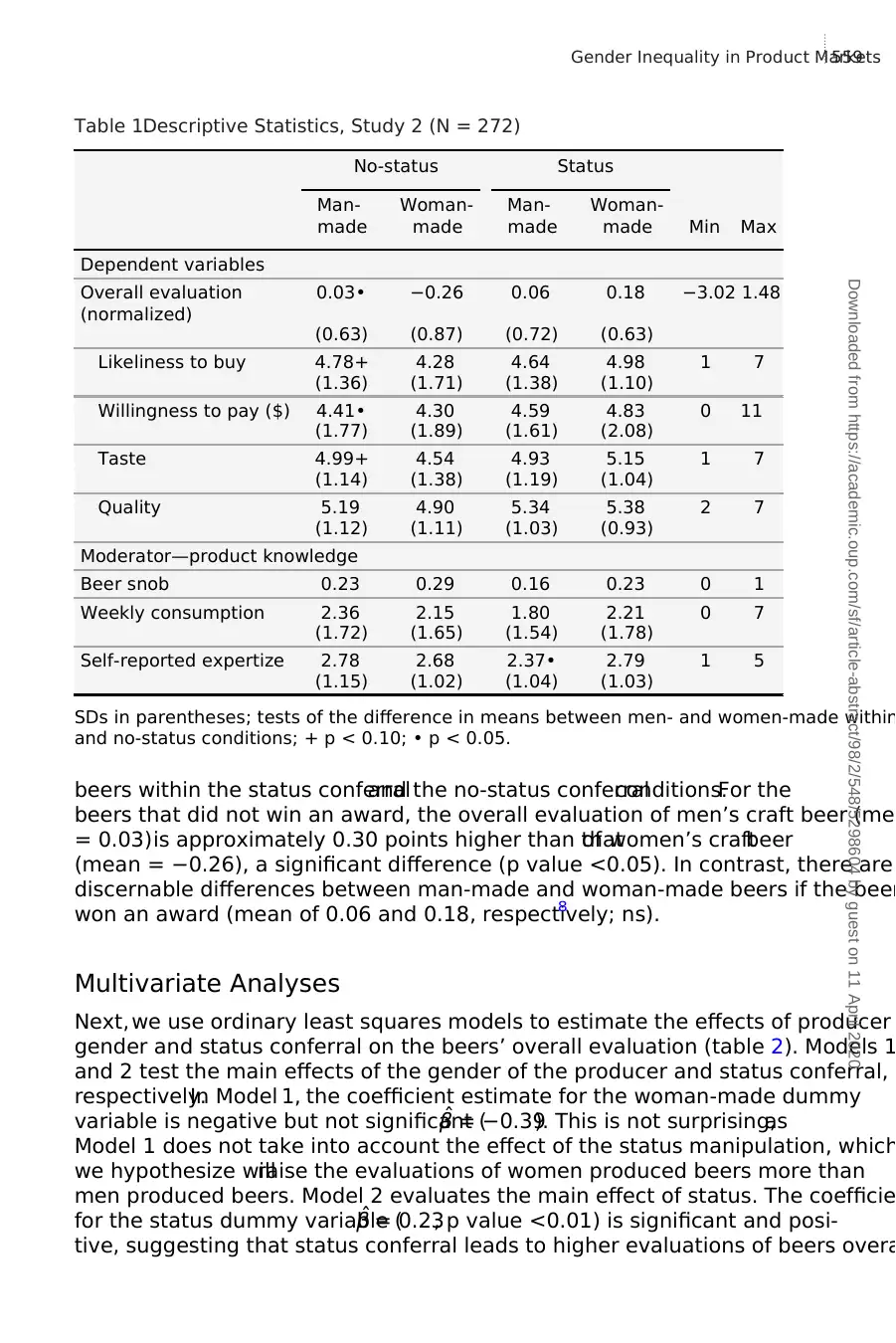
beers within the status conferraland the no-status conferralconditions.For the
beers that did not win an award, the overall evaluation of men’s craft beer (mea
= 0.03)is approximately 0.30 points higher than thatof women’s craftbeer
(mean = −0.26), a significant difference (p value <0.05). In contrast, there are
discernable differences between man-made and woman-made beers if the beer
won an award (mean of 0.06 and 0.18, respectively; ns).8
Multivariate Analyses
Next, we use ordinary least squares models to estimate the effects of producer
gender and status conferral on the beers’ overall evaluation (table 2). Models 1
and 2 test the main effects of the gender of the producer and status conferral,
respectively.In Model 1, the coefficient estimate for the woman-made dummy
variable is negative but not significant (βˆ = −0.39). This is not surprising,as
Model 1 does not take into account the effect of the status manipulation, which
we hypothesize willraise the evaluations of women produced beers more than
men produced beers. Model 2 evaluates the main effect of status. The coefficie
for the status dummy variable (βˆ = 0.23, p value <0.01) is significant and posi-
tive, suggesting that status conferral leads to higher evaluations of beers overa
No-status Status
Man-
made
Woman-
made
Man-
made
Woman-
made Min Max
Dependent variables
Overall evaluation
(normalized)
0.03• −0.26 0.06 0.18 −3.02 1.48
(0.63) (0.87) (0.72) (0.63)
Likeliness to buy 4.78+ 4.28 4.64 4.98 1 7
(1.36) (1.71) (1.38) (1.10)
Willingness to pay ($) 4.41• 4.30 4.59 4.83 0 11
(1.77) (1.89) (1.61) (2.08)
Taste 4.99+ 4.54 4.93 5.15 1 7
(1.14) (1.38) (1.19) (1.04)
Quality 5.19 4.90 5.34 5.38 2 7
(1.12) (1.11) (1.03) (0.93)
Moderator—product knowledge
Beer snob 0.23 0.29 0.16 0.23 0 1
Weekly consumption 2.36 2.15 1.80 2.21 0 7
(1.72) (1.65) (1.54) (1.78)
Self-reported expertize 2.78 2.68 2.37• 2.79 1 5
(1.15) (1.02) (1.04) (1.03)
SDs in parentheses; tests of the difference in means between men- and women-made within
and no-status conditions; + p < 0.10; • p < 0.05.
Table 1.Descriptive Statistics, Study 2 (N = 272)
Gender Inequality in Product Markets559 Downloaded from https://academic.oup.com/sf/article-abstract/98/2/548/5298604 by guest on 11 April 2020
beers that did not win an award, the overall evaluation of men’s craft beer (mea
= 0.03)is approximately 0.30 points higher than thatof women’s craftbeer
(mean = −0.26), a significant difference (p value <0.05). In contrast, there are
discernable differences between man-made and woman-made beers if the beer
won an award (mean of 0.06 and 0.18, respectively; ns).8
Multivariate Analyses
Next, we use ordinary least squares models to estimate the effects of producer
gender and status conferral on the beers’ overall evaluation (table 2). Models 1
and 2 test the main effects of the gender of the producer and status conferral,
respectively.In Model 1, the coefficient estimate for the woman-made dummy
variable is negative but not significant (βˆ = −0.39). This is not surprising,as
Model 1 does not take into account the effect of the status manipulation, which
we hypothesize willraise the evaluations of women produced beers more than
men produced beers. Model 2 evaluates the main effect of status. The coefficie
for the status dummy variable (βˆ = 0.23, p value <0.01) is significant and posi-
tive, suggesting that status conferral leads to higher evaluations of beers overa
No-status Status
Man-
made
Woman-
made
Man-
made
Woman-
made Min Max
Dependent variables
Overall evaluation
(normalized)
0.03• −0.26 0.06 0.18 −3.02 1.48
(0.63) (0.87) (0.72) (0.63)
Likeliness to buy 4.78+ 4.28 4.64 4.98 1 7
(1.36) (1.71) (1.38) (1.10)
Willingness to pay ($) 4.41• 4.30 4.59 4.83 0 11
(1.77) (1.89) (1.61) (2.08)
Taste 4.99+ 4.54 4.93 5.15 1 7
(1.14) (1.38) (1.19) (1.04)
Quality 5.19 4.90 5.34 5.38 2 7
(1.12) (1.11) (1.03) (0.93)
Moderator—product knowledge
Beer snob 0.23 0.29 0.16 0.23 0 1
Weekly consumption 2.36 2.15 1.80 2.21 0 7
(1.72) (1.65) (1.54) (1.78)
Self-reported expertize 2.78 2.68 2.37• 2.79 1 5
(1.15) (1.02) (1.04) (1.03)
SDs in parentheses; tests of the difference in means between men- and women-made within
and no-status conditions; + p < 0.10; • p < 0.05.
Table 1.Descriptive Statistics, Study 2 (N = 272)
Gender Inequality in Product Markets559 Downloaded from https://academic.oup.com/sf/article-abstract/98/2/548/5298604 by guest on 11 April 2020
⊘ This is a preview!⊘
Do you want full access?
Subscribe today to unlock all pages.

Trusted by 1+ million students worldwide
1 out of 30
Your All-in-One AI-Powered Toolkit for Academic Success.
+13062052269
info@desklib.com
Available 24*7 on WhatsApp / Email
![[object Object]](/_next/static/media/star-bottom.7253800d.svg)
Unlock your academic potential
Copyright © 2020–2025 A2Z Services. All Rights Reserved. Developed and managed by ZUCOL.